Aperture's Blog, page 11
February 14, 2025
How Susan Meiselas Documented Nicaragua’s Revolution
Susan Meiselas first traveled to Nicaragua in June 1978. Three years prior, Meiselas had joined Magnum Photos, and this trip marked her first experience working in conflict photography. Meiselas went on to spend just over a year in Nicaragua, documenting an extraordinary narrative of a nation in turmoil, from the powerful evocation of Somoza regime during its decline in the late 1970s, to the evolution of the popular resistance that led to the triumph of the Sandinista revolution in 1979.
Originally published in 1981, and now in a third edition, Susan Meiselas’s Nicaragua: June 1978–July 1979 is a contemporary classic and formative contribution to the literature of concerned photography. In the decades following the original publication, Meiselas has continued to contextualize her photographs and relate them to history as it unfolded. In this new edition, thirty images are linked via QR codes to excerpts from films by the artist, including Pictures from a Revolution (1991, codirected with Richard P. Rogers and Alfred Guzzetti) in which Meiselas tracks down and interviews the people she photographed, and Reframing History (2004, codirected with Alfred Guzzetti), which highlights her collaborations with local communities installing mural-sized images in the places where they were originally taken, eliciting the memories and reflections of those passing by.
By extending and deepening her work, Meiselas asks us “to consider not only the specific timeframe of this book, but to think about the broader perspective of history unfolding, and how in the passage of time a photograph of a single moment in a person’s life shifts its meanings as well as our perception of it.” In an interview from the book, Meiselas speaks with Magnum Foundation’s director, Kristen Lubben, on how the work of this evolving project has been circulated, revisited, and repatriated—and how and why it endures.
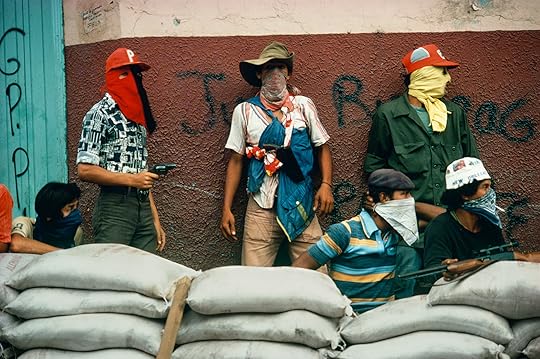 Susan Meiselas, Awaiting counter attack by the Guard in Matagalpa, 1978–79
Susan Meiselas, Awaiting counter attack by the Guard in Matagalpa, 1978–79 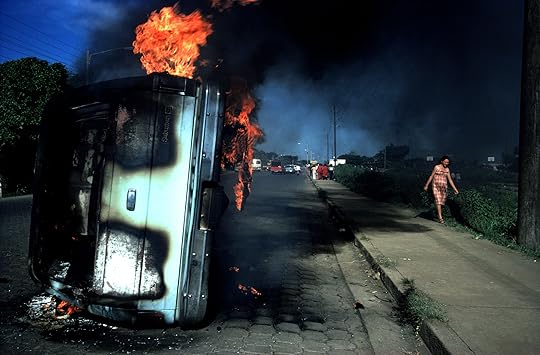 Susan Meiselas, Car of a Somoza informer burning in Managua, 1978–79
Susan Meiselas, Car of a Somoza informer burning in Managua, 1978–79 Kristen Lubben: Before going to Nicaragua in 1978 you had never photographed conflict nor had you worked for the media. You were coming from what seems like a totally different universe than that of a war photographer: You were working on Prince Street Girls, portraits of adolescent girls in your Little Italy neighborhood, and two years earlier you had published Carnival Strippers, an extended photo-essay on women in traveling strip shows in New England, now a photo classic.
Susan Meiselas: Yes, Nicaragua was a quantum leap for me. Not only was the subject matter of Carnival Strippers and Prince Street Girls different than what I would encounter in Nicaragua, but I was also used to working in a different way—having extended relationships with subjects, and bringing back contact sheets for them to respond to. Carnival Strippers was the work I submitted to join Magnum, the photographer’s collective.
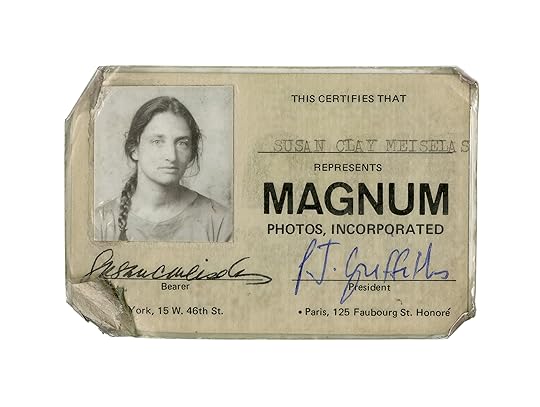
Magnum Photos press ID, 1978
Lubben: And did joining Magnum lead you to go to Nicaragua?
Meiselas: At Magnum there was a culture that supported taking initiative—going to a place not knowing more than whatever you could scrape together from afar. Remember, we are in a transformed world of information now; you can sit at home and do research online and feel you know a place without ever going there. But I had no idea what Nicaragua even looked like. I was reading snippets, these little stories that were ten lines long, and I wasn’t seeing any photographs with them. That made me think, “Maybe I should go—but how do you do that?”
The tipping point was a full-page New York Times article in January of 1978 about the assassination of Pedro Joaquín Chamorro Cardenal, the editor of the newspaper La Prensa and the country’s most outspoken opposition figure. Maybe it was the size of that article; maybe it was the way in which it implicated America in supporting the Somoza family. It all just started to turn in my head.
Through Gilles Peress at Magnum I met Peter Pringle, a British journalist working for the London Times. He had just been to Nicaragua, writing about the history of the English on the Atlantic coast, but hadn’t touched on what was happening with the brewing revolution, and was curious to do that. So I said, “Great.” I just assumed that’s what you do: find a writer you want to work with, and you go and do it. Then between February and when I ultimately left in June, there were more stories about Nicaragua—strikes and student protests, small events that kept percolating through the news. Peter, meanwhile, got bogged down and kept delaying the trip. One day I was at Magnum and [photographer] Richard Kalvar said, “I thought you were going to Nicaragua.” And I said, “Well, Peter can’t go . . . ” He said, “What do you need him for? You’re going to take the pictures.” It was kind of like, “Wow. Okay. That’s another idea.” That nudge helped me make the leap.
And I went. With no concrete plan in place. I didn’t speak Spanish. I didn’t even know where I would stay. It sounds nuts, but it’s true.
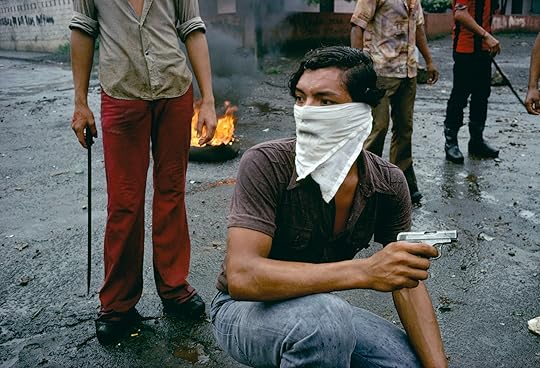 Susan Meiselas, Street fighter in Managua, 1978–79
Susan Meiselas, Street fighter in Managua, 1978–79 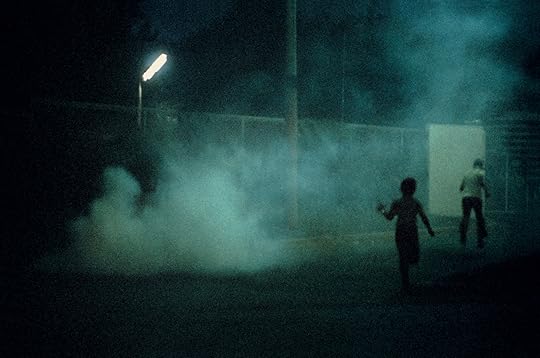 Susan Meiselas, Student demonstration broken up by the National Guard using tear gas, Managua, 1978–79
Susan Meiselas, Student demonstration broken up by the National Guard using tear gas, Managua, 1978–79 Lubben: So how did you get started? Did you just walk around Managua, taking pictures?
Meiselas: Yes, walking around, really feeling like I didn’t know what I was doing. But the first day, I went to La Prensa and I met with Carlos Fernando Chamorro, the son of the man who had been killed, and Margarita Montealegre, who was a young photographer at the newspaper. I was lucky that they both spoke English.
Lubben: Were there any other foreign photographers there?
Meiselas: There was one other, a Colombian photographer who came for a protest march, around the time Los Doce (The Twelve) returned to Nicaragua. Los Doce was an alliance of middle-class businessmen, lawyers, and professionals who aligned themselves with the Sandinistas against Somoza. They were kind of a legal front. The Sandinistas were underground. During that first trip I met many people who were sympathetic to the Sandinistas, but I didn’t meet anybody inside the organization. Or, if I did, I didn’t know that they were.
 Susan Meiselas: Nicaragua 50.00 Originally published in 1981, and now in a third edition, Susan Meiselas’s Nicaragua is a contemporary classic—a seminal contribution to the literature of concerned photography.
Susan Meiselas: Nicaragua 50.00 Originally published in 1981, and now in a third edition, Susan Meiselas’s Nicaragua is a contemporary classic—a seminal contribution to the literature of concerned photography. $50.0011Add to cart
[image error] [image error]
In stock
Susan Meiselas: NicaraguaPhotographs by Susan Meiselas. Text by Kristen Lubben.
$ 50.00 –1+$50.0011Add to cart
View cart Description
Originally published in 1981, and now in a third edition, Susan Meiselas’s Nicaragua is a contemporary classic—a seminal contribution to the literature of concerned photography.
Nicaragua: June 1978–July 1979 forms an extraordinary narrative of a nation in turmoil. Starting with a powerful and chilling evocation of the Somoza regime during its decline in the late 1970s, the images trace the evolution of the popular resistance that led to the triumph of the Sandinista revolution in 1979. The book includes interviews with various participants in the revolution, along with letters, poems, and statistics.
In the decades following the original publication, Meiselas has continued to contextualize her photographs and relate them to history as it unfolded. Multiple editions build upon this body of work to evoke and conjure up the reality of people’s lives and aspirations, their victories and disappointments. In this new edition, thirty images are linked via QR codes to excerpts from the films Pictures from a Revolution (1991, codirected with Richard P. Rogers and Alfred Guzzetti) in which Meiselas tracks down and interviews the people she photographed, and Reframing History (2004, codirected with Alfred Guzzetti), her collaboration with local communities in installing mural-sized images in the places where they were originally taken, eliciting the memories and reflections of those passing by. By extending and deepening her work, Meiselas asks us “to consider not only the specific timeframe of this book, but to think about the broader perspective of history unfolding, and how in the passage of time a photograph of a single moment in a person’s life shifts its meanings as well as our perception of it.” An interview with the artist by Magnum Foundation’s director, Kristen Lubben, addresses how the work of this evolving project has been circulated, revisited, and repatriated—and how and why it endures.
DetailsFormat: Hardback
Number of pages: 128
Number of images: 75
Publication date: 2025-03-11
Measurements: 10.8 x 8.5 inches
ISBN: 9781597115902
Susan Meiselas (born in Baltimore, 1948) is a documentary photographer based in New York. She received her BA from Sarah Lawrence College and her MA in visual education from Harvard University. Her first book, Carnival Strippers, was published in 1976. That year, Meiselas joined Magnum Photos, where she remains a member, and since 2007 has served as president of the Magnum Foundation. Her numerous awards include a Guggenheim Fellowship, Deutsche Börse Photography Foundation Prize, and the first Women in Motion Award from Kering and Rencontres d’Arles.
Kristen Lubben is a curator, writer, editor, and executive director of the Magnum Foundation.
 Featured 15 Essential Photobooks by Women Photographers
Featured 15 Essential Photobooks by Women Photographers 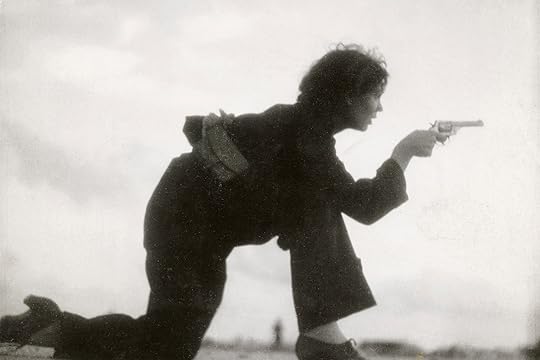 Photobooks When Women Photographers Went to War
Photobooks When Women Photographers Went to War Lubben: Did you have any frame of reference in your own history for what you were experiencing in those early days in Nicaragua?
Meiselas: The students went on strike at the university in Managua when I was there. I might have chosen that image in the book because of the association I made with marching on Washington against the Vietnam War in ’68 during my own student years. I’m also of that generation where some people joined SDS (Students for a Democratic Society) and the Weather Underground, though that was not what I did. But the language of opposition was very strong at that time, along with the feeling that change was possible in America.
I think that’s probably why I was so intrigued by the question of how the Nicaraguans were going to overthrow a dictatorship that had been in place for fifty years. There were various sectors throwing their weight together, building momentum. The businessmen who owned the factories were supporting the workers who were on strike. Of course, no one believed they were really going to unify to the point that they would overthrow Somoza. The confrontation wasn’t constant, it wasn’t every day. It wasn’t until the insurrection in August 1978 that I was really in the middle of a war, and that was something totally unfamiliar to me.
Lubben: Is that when you shifted to shooting primarily in color rather than black and white?
Meiselas: When I first went to Nicaragua, I was working with two cameras, one loaded with black-and-white film and one with color. I started out thinking that I’d use mostly black and white, and it progressively became almost all color. It didn’t happen in the first six weeks; I think it just slowly evolved. I didn’t really switch; I think I just put more weight on one foot at a certain point. As time went on, the black and white became more like a sketchbook, so I knew what I had when I processed the film in Nicaragua. It was my reference set. I shot that way later in El Salvador, too. But in El Salvador I made the opposite decision. Although there is color from El Salvador that I like quite a lot, at that time I really decided the work was stronger in black and white.
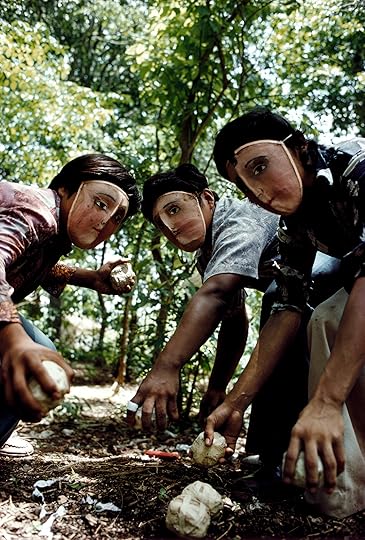 Susan Meiselas, Youths practice throwing contact bombs in forest surrounding Monimbo, 1978–79
Susan Meiselas, Youths practice throwing contact bombs in forest surrounding Monimbo, 1978–79  Susan Meiselas, Traditional Indian dance mask from the town of Monimbo, adopted by the rebels during the fight against Somoza to conceal identity, 1978–79
Susan Meiselas, Traditional Indian dance mask from the town of Monimbo, adopted by the rebels during the fight against Somoza to conceal identity, 1978–79 Lubben: You felt Nicaragua was better served by color film.
Meiselas: Yes. Well, not “better served,” because that sounds like I’m in service of it. It’s that it captured what it felt like—the way people dressed, the way they painted their houses.
Lubben: But why wasn’t that true in El Salvador?
Meiselas: El Salvador was darker because of the brutality of the military dictatorship throughout the civil war. People dressed that same way, but I didn’t feel the same spirit of—maybe optimism—in El Salvador. It was really a crushing place to be. Black and white definitely captured that mood better.
Lubben: Your use of color film turned out to be controversial: In 1981 when you published the images in Nicaragua, critics challenged your choice.
Meiselas: Photographs in newspapers were still in black and white, and color images of war were not yet familiar to people. Of course, now no one even thinks about this. At the time, I wasn’t taking a position in the debate about whether war should or shouldn’t be shown only in black and white. And I wasn’t responding to editorial pressures to work in color, as has also been suggested. I worked in color because I was responding to what I was seeing, and maybe feeling.
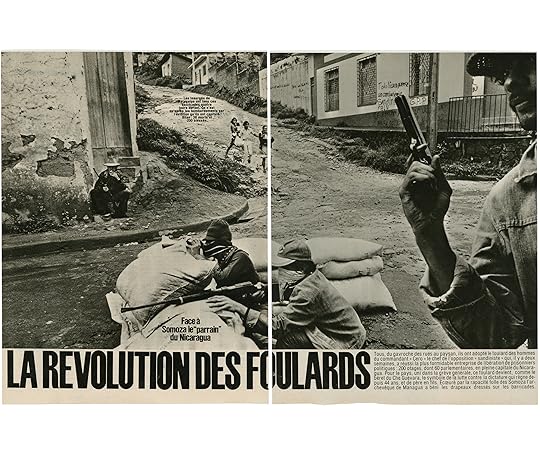 Paris Match, September 15, 1978
Paris Match, September 15, 1978 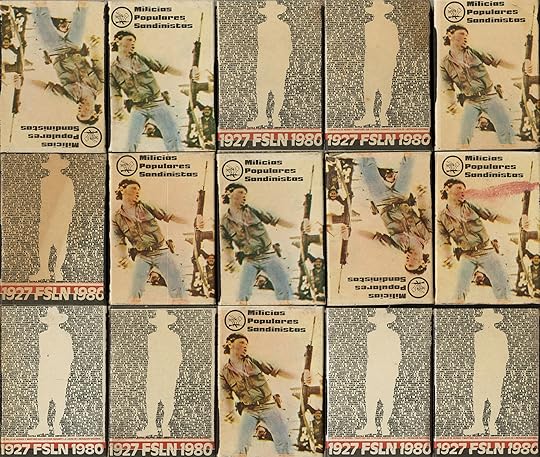 Matchboxes commemorating the first anniversary of the revolution, July 19, 1980
Matchboxes commemorating the first anniversary of the revolution, July 19, 1980 Lubben: Why did you decide to do the book? Were you responding to the way your images were used in the press?
Meiselas: With Strippers, the women and I were sharing a process. I was hearing them reflect on what their concerns were and how they saw the photographs of themselves. With the media distribution of my work in Nicaragua I had absolutely no connection at all to the process of selection, diffusion, and impact on peoples’ lives, or how they felt about it. When you ask the question, why did I do a book? I wanted to contextualize the work. It didn’t matter how many pictures had been reproduced in multiple magazines around the world. I wanted to bring them together in some way that would give coherence to my experience. At the same time, I was thoroughly aware that it was incomplete.
I continue to discover how pictures circulate, including in Nicaragua itself, where the images have often been reappropriated. One image in particular, known as “Molotov Man” [plate 64], appeared on matchbox covers, and then painted on walls. “Bareta,” the man in the picture, became a symbol for the revolution. Some images have separate lives. This one has now entered a complex debate about copyright and free use as well as who has the right to an image, including the subjects themselves.
Lubben: Two of your films about Nicaragua, Pictures from a Revolution (1991) and Reframing History (2004), both speak to your longstanding interest in returning to the scene and in repatriating your work. In Pictures, you went back to Nicaragua ten years after the revolution to track down the subjects in your photographs. What initially compelled you to do the film?
Meiselas: I became preoccupied with what had happened to the people in my photographs and wondered where they were and what they thought about the political shift in Nicaragua. It was something I thought about often, especially traveling between El Salvador and Nicaragua during those years of continuous civil war. Alfred Guzzetti and Dick Rogers and I had done an earlier film together in 1986, Living at Risk, about an upper-middle-class Nicaraguan family, but the stories behind my pictures of the insurrection had a more emotional center for me. Alfred had the idea for a more ambitious film of historical scope, consisting entirely of interviews, without a narrator. His model was Marcel Ophuls’s great documentary, The Sorrow and the Pity, about the French Resistance during the Nazi occupation. I honestly didn’t feel I had the depth of knowledge to do that idea justice. My proposal was more modest.
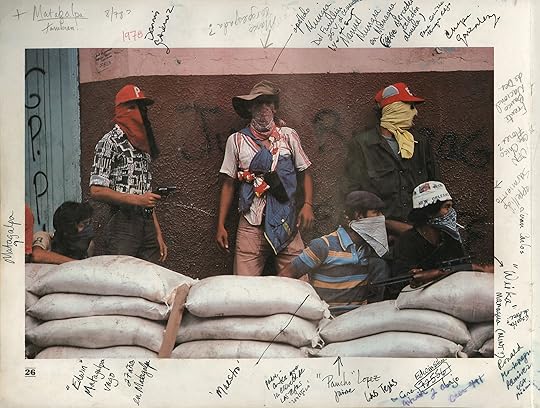 Notes gathered from Nicaraguans while searching for subjects of the original photos during the making of Pictures from a Revolution in 1989
Notes gathered from Nicaraguans while searching for subjects of the original photos during the making of Pictures from a Revolution in 1989 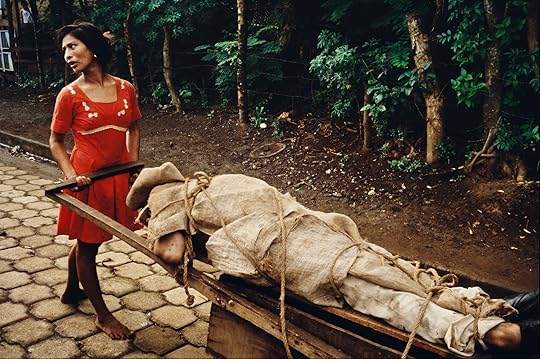 Susan Meiselas, Monimbo woman carrying her dead husband home to be buried in their backyard, 1978–79
Susan Meiselas, Monimbo woman carrying her dead husband home to be buried in their backyard, 1978–79 Lubben: What was it like to talk to these subjects after all this time?
Meiselas: I especially loved the “search mode,” as we called it then, finding the people, which is best captured in the sequence of smaller and smaller roads that we traveled in order to find Nubia, the woman in the red dress. Her interview with all the kids surrounding her was particularly moving. She and I had shared a moment in time, and she remembered the conditions better than I did; she was carrying her dead husband in a wheelbarrow while bullets were flying all around us. It was a very special moment when she touched the same earrings she was wearing in the photo or pointed to the new shoes she had buried him with. She had a real sense of pride, having buried him all by herself—and at age fourteen!
Lubben: In your view, how was the film received?
Meiselas: I suppose we were initially surprised by the response, especially that many people wanted to see the photographs, not hear from the people in them. I am still fascinated by that schism between the aesthetic object—the “frame”—versus the lives that come forth from behind the photograph. Is it that we at times want the distance that a formal composition can give us or that we just don’t want to know or feel too much involvement? A frozen life in a photograph is perplexing for me . . . I suppose it’s part of the “going back” that I am often inclined to do. As much as I like the formalism, I am propelled to reconnect. I seek the feeling that comes from the connection. I think that moment of engagement is ultimately what sustains me as a photographer.
Of course time allows us to reflect. In the case of our film, perhaps we were too close to the time of those events; no one wanted to think about the failure of the revolution, and the Left wanted to simply blame the electoral defeat of the Sandinistas on the aggression of the US. The complexity of those years still needs to be reconsidered.
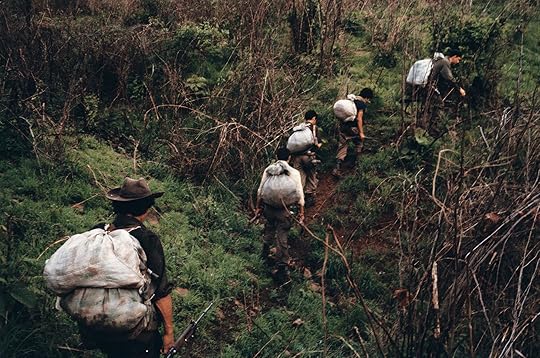
Susan Meiselas, Toward Sandinista training camp in the mountains north of Estelí, 1978–79
var container = ''; jQuery('#fl-main-content').find('.fl-row').each(function () { if (jQuery(this).find('.gutenberg-full-width-image-container').length) { container = jQuery(this); } }); if (container.length) { const fullWidthImageContainer = jQuery('.gutenberg-full-width-image-container'); const fullWidthImage = jQuery('.gutenberg-full-width-image img'); const watchFullWidthImage = _.throttle(function() { const containerWidth = Math.abs(jQuery(container).css('width').replace('px', '')); const containerPaddingLeft = Math.abs(jQuery(container).css('padding-left').replace('px', '')); const bodyWidth = Math.abs(jQuery('body').css('width').replace('px', '')); const marginLeft = ((bodyWidth - containerWidth) / 2) + containerPaddingLeft; jQuery(fullWidthImageContainer).css('position', 'relative'); jQuery(fullWidthImageContainer).css('marginLeft', -marginLeft + 'px'); jQuery(fullWidthImageContainer).css('width', bodyWidth + 'px'); jQuery(fullWidthImage).css('width', bodyWidth + 'px'); }, 100); jQuery(window).on('load resize', function() { watchFullWidthImage(); }); const observer = new MutationObserver(function(mutationsList, observer) { for(var mutation of mutationsList) { if (mutation.type == 'childList') { watchFullWidthImage();//necessary because images dont load all at once } } }); const observerConfig = { childList: true, subtree: true }; observer.observe(document, observerConfig); }Lubben: You also made a film with Marc Karlin in 1985 called Voyages, for Channel 4 in England, in which you reflect on your role in Nicaragua through a series of letters to the filmmaker. At the end of that film you say: “I have pictures; they have a revolution.” In that poetic statement you seem to be finally moving on from Nicaragua, saying, in effect: “This is done for me; I’m no longer inside it. I’m now outside it.”
Meiselas: It’s a really strong line for me still. I think it was a painful acknowledgment of the limits of my work. Ultimately, I was as inside as an outsider can be, but you’re always an outsider. They had a society to build. They were going to start from the sidewalks on up; they wanted to transform everything. And I wasn’t going to be part of that.
If El Salvador hadn’t erupted, maybe I would have stayed longer. But my guess is that I would have started to feel I had a role somewhere else. It’s not to say I didn’t want to go back; I wanted to sustain relationships there but not stay. What I chose to do within the first year following the triumph was work with local photographers as they built the first newspaper. So I contributed in the ways that felt within the bounds of what I particularly could do.
Advertisement
googletag.cmd.push(function () {
googletag.display('div-gpt-ad-1343857479665-0');
});
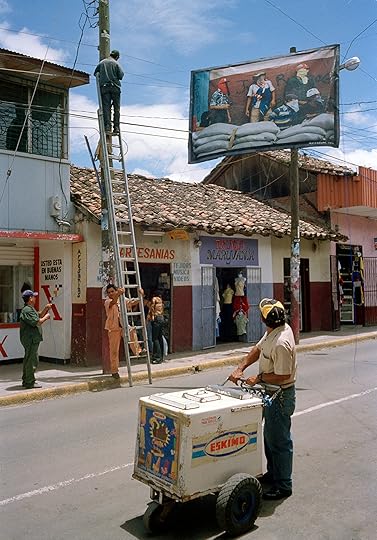 From Reframing History,a mural in the landscape where the picture was originally taken, Matagalpa, 2004
From Reframing History,a mural in the landscape where the picture was originally taken, Matagalpa, 2004Lubben: And of course you went back with your project Reframing History and transformed nineteen of your pictures into murals and hung them in public places, on the sites where they were originally taken twenty-five years before.
Meiselas: Yes. Reframing History came from a different process. I was digitizing part of my archive, and I was looking at all that work thinking, “Why bother to digitize it? What value do these pictures have, and for whom?” I thought, “Would they be of any value to the archives in Nicaragua? Is it of interest even to the people who were in the pictures twenty-five years ago, or the people who weren’t there but had heard about it?” That’s what led me to the idea of bringing mural-sized images back.
I found out about the Institute of History and started a dialogue with them. I also asked Carlos Fernando, my old friend, and Gioconda Belli, a Nicaraguan poet, if they thought my idea would seem appropriate to people there.
Ultimately, I collaborated with the Institute of History, who contacted the mayors of the four towns, and I chose nineteen pictures—symbolic of July 19, the day of the triumph over Somoza in 1979. Even up to the day that we arrived with the murals, it wasn’t clear if we were going to be able to put the murals on what had been the National Palace. Everything got negotiated—in each town, with each mayor, with each wall. You know the famous photograph on the cover? The man who lives in that house didn’t want the photograph on the wall of his house, so we hung the banner over the street. He was fine about that. He just didn’t want to have anybody mistakenly think that he was a Sandinista. There were other people who identified with the photographs. Ernesto’s mother was deeply honored, having the photograph of her son running across the street illuminated at night by a street lamp. There were many different kinds of reactions to seeing the murals, which we recorded on video; listening to the comments and watching people look at the images back in the landscape.
At that same time, there was also a film festival. It was really amazing for people because they had not seen any films from the 1970s into the ’80s. There were all these college kids who had heard about the revolution from their parents, and suddenly they saw images of Nicaraguans in the streets and realized they really missed out. It was like the people who felt they missed ’68 in our country.
 Susan Meiselas, First day of popular insurrection, August 26, 1978
Susan Meiselas, First day of popular insurrection, August 26, 1978 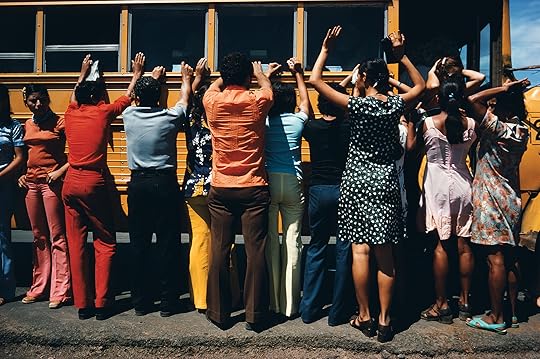 Susan Meiselas, Searching everyone traveling by car, truck, bus, or foot, 1978–79
Susan Meiselas, Searching everyone traveling by car, truck, bus, or foot, 1978–79Courtesy the artist/Magnum Photos
Lubben: In the 2008 edition of the book you included a DVD with the films Pictures from a Revolution and Reframing History; in this 2016 edition, in place of the DVD—now well on its way to becoming a defunct technology—you have introduced an augmented reality (AR) customized app, which takes the reader to short clips of the films that relate to specific images in the book. (Editor’s note: In this 2025 edition, the AR has been replaced with QR codes, the video clips are expanded, and the number of linked images has increased.)
Meiselas: The change in how we are including the films is both pragmatic and conceptual. I am curious to see if linking film clips closer to selected images will create the possibility for greater engagement. The idea of bringing together the original images with snippets from the films was one I first explored in exhibition installations, when I paired photographs with their corresponding section of the films in which people reflected ten years after the image was made.
Lubben: You also have chosen to use AR technology to link to a portfolio of previously unpublished images of life in Nicaragua in the years following the revolution.
Meiselas: Yes, the selection of those images was inspired by what Padre Ernesto Cardenal, the renowned poet and priest, wrote about during and after the popular insurrection, including the excitement and challenges of transforming Nicaraguan culture in the wake of the triumph. The photographs show small everyday moments, alongside the dramatic events of that year, and their hopes for a normalized life. The revolution was the beginning of a process—of reconstruction and remembrance—not the end. A series of these images appears as a little movie that can be accessed at the end of the Chronology section.
Lubben: How do you imagine that accessing a film clip by holding a smartphone over a still image in the book will change the experience of the films?
Meiselas: With the Nicaragua project, I have always been really interested in the way that history evolves, and the AR process enables a different way to look at that extending timeline and relate it back to the images. The risk with AR is that unlike with a linear movie, where you can capture your viewer and hold them through a narrative, you can’t do that with this more fractured approach. Through twenty short excerpts, we will be including about one-third of the film Pictures from a Revolution. How is that a fundamentally different experience? Will readers then be propelled to download or stream the full ninety-minute film? I don’t know.
I’m asking the reader to consider not only the specific timeframe of this book (1978–79), but to think about the broader concept of history unfolding, and how a photograph from a single moment in a person’s life shifts and our perception expands over the passage of time.
This interview originally appeared in Susan Meiselas: Nicaragua (Aperture, 2025).
12 Photobooks That Celebrate Black Voices and History
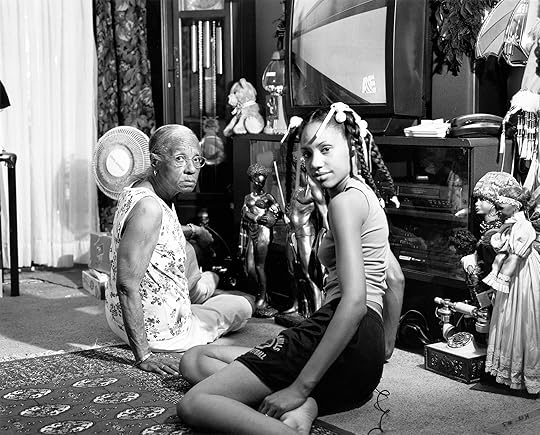 LaToya Ruby Frazier, Grandma Ruby and Me, 2005
LaToya Ruby Frazier, Grandma Ruby and Me, 2005Courtesy the artist and Gladstone Gallery
Race Stories: Essays on the Power of Images, by Maurice Berger (2024)
In Race Stories: Essays on the Power of Images, the late cultural historian Maurice Berger explores the intersections of photography, race, and visual culture. Between 2012 and 2019, Berger first shared these essays in a monthly column on the New York Times Lens blog. Copublished by Aperture and the New York Times, this volume marks the first title in Aperture’s Vision & Justice Book Series, created and coedited by Drs. Sarah E. Lewis, Leigh Raiford, and Deborah Willis, which reexamines and redresses historical narratives of photography, race, and justice.
Edited by Marvin Heiferman, this anthology brings together seventy-one essays that examine the transformational role photography plays in shaping ideas and attitudes about race, and how photographic images have been instrumental in both perpetuating and combating racial stereotypes. From pivotal moments in American history to the ways in which images by LaToya Ruby Frazier, Gordon Parks, Jamel Shabazz, Pete Souza help us see the world anew, Race Stories showcases Berger’s lifelong endeavor to distill complex ideas about racial equity. As Henry Louis Gates, Jr., writes in the book’s foreword: “This collection establishes not only Maurice Berger’s place in the history of the criticism of photography but also his role as a social philosopher determined to underscore, essay by essay, all that unites us as human beings.”
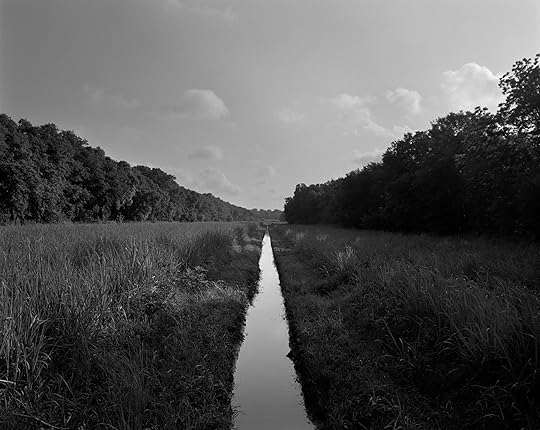 Dawoud Bey, Irrigation Ditch, 2019
Dawoud Bey, Irrigation Ditch, 2019Courtesy the artist
Dawoud Bey: Elegy (2023)
In Elegy, Dawoud Bey focuses on the landscape to create a portrait of the early African American presence in the United States. Renowned for his Harlem street scenes and expressive portraits, this volume marks a continuation of Bey’s ongoing work exploring African American history. Copublished by Aperture and the Virginia Museum of Fine Arts, Elegy focuses on three of Bey’s landscape series—Night Coming Tenderly, Black (2017); In This Here Place (2021); and Stony the Road (2023)—shedding a light on the deep historical memory still embedded in the geography of the US.
Bey takes viewers to the historic Richmond Slave Trail in Virginia, where Africans were marched onto auction blocks; to the plantations of Louisiana, where they labored; and along the last stages of the Underground Railroad in Ohio, where fugitives sought self-emancipation. By interweaving these bodies of work into an elegy in three movements, Bey not only evokes history but retells it through historically grounded images that challenge viewers to go beyond seeing and imagine lived experiences. “This is ancestor work,” Bey tells the New York Times. “Stepping outside the art context, the project context, this is the work of keeping our ancestors present in the contemporary conversation.”
 Arielle Bobb-Willis, Austin, 2020
Arielle Bobb-Willis, Austin, 2020Courtesy the artist
Arielle Bobb-Willis: Keep the Kid Alive (2024)
Born in 1994 in New York, Arielle Bobb-Willis first started to experiment with photography at the age of fourteen, when she was gifted an old Nikon N80 film camera by her high school history teacher after her family relocated to South Carolina. Since then, Bobb-Willis has become a rising photographer, having shot commissions for a range of magazines and fashion brands including Vogue, the New York Times, Vanity Fair, Nike, Hermès, and more. In 2024, Aperture published the artist’s first monograph, Keep the Kid Alive. Previously, Aperture had featured Bobb-Willis’s work in the The New Black Vanguard (2017), which highlights the work of fifteen contemporary Black photographers rethinking the possibilities of representation.
In Keep the Kid Alive, Bobb-Willis invites audiences into a brightly imaginative world, filled with dynamic colors, gestures, and unusual poses of the artist’s own creation. Transforming the streets of New Orleans, New York, and Los Angeles into lush backdrops for her wonderfully surreal tableaux, Bobb-Willis makes unforgettable images that expand the genres of fashion and art photography. As Bobb-Willis notes in an interview from the book, “Photography is, and will always be, a daily practice of falling in love with as many things as I can.”
Collect a limited-edition print by Arielle-Bobb Willis from Keep the Kid Alive.
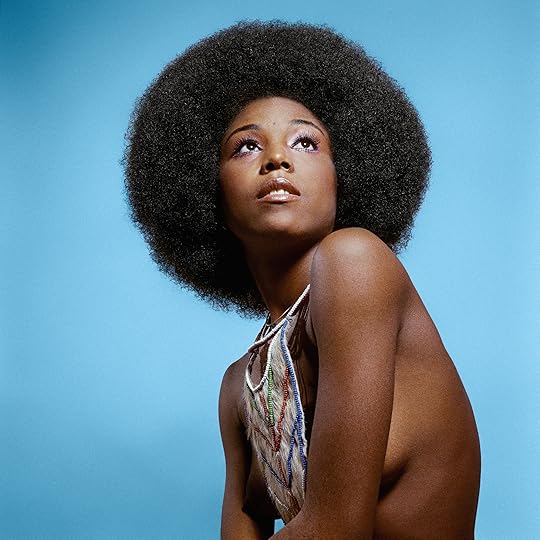 Kwame Brathwaite, Model wearing a natural hairstyle, AJASS, Harlem, ca. 1970
Kwame Brathwaite, Model wearing a natural hairstyle, AJASS, Harlem, ca. 1970Courtesy the artist and Philip Martin Gallery, Los Angeles
Kwame Brathwaite: Black Is Beautiful (2019)
Kwame Brathwaite’s photographs from the 1950s and ’60s transformed how we define Blackness. Using his photography to popularize the slogan “Black Is Beautiful,” Brathwaite challenged mainstream beauty standards of the time that excluded women of color.
Brathwaite, who passed away in 2023, was born in Brooklyn and part of the second-wave Harlem Renaissance. Brathwaite and his brother Elombe Brath founded the African Jazz-Art Society & Studios (AJASS) and the Grandassa Models. AJASS was a collective of artists, playwrights, designers, and dancers; Grandassa Models was a modeling troupe for Black women. Working with these two organizations, Brathwaite organized fashion shows featuring clothing designed by the models themselves, created stunning portraits of jazz luminaries, and captured behind-the-scenes photographs of the Black arts community, including Max Roach, Abbey Lincoln, and Miles Davis.
Black Is Beautiful is the first-ever monograph of his work, showcasing Brathwaite’s riveting message about Black culture and freedom. “To ‘Think Black’ meant not only being politically conscious and concerned with issues facing the Black community,” writes Tanisha C. Ford, “but also reflecting that awareness of self through dress and self-presentation. . . . [They] were the woke set of their generation.”
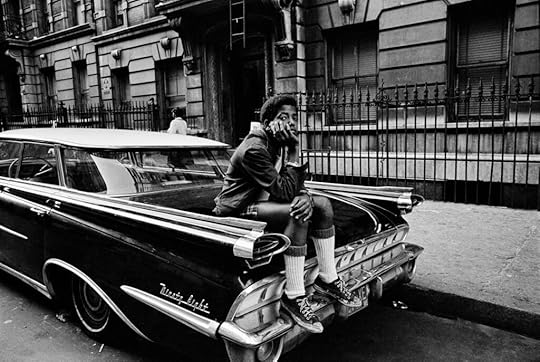 Ernest Cole, Untitled, New York City, 1968–71
Ernest Cole, Untitled, New York City, 1968–71© The Ernest Cole Family Trust
Ernest Cole: The True America (2024)
After fleeing South Africa to publish his landmark book House of Bondage in 1967 (reissued by Aperture in 2022) on the horrors of apartheid, Ernest Cole became a “banned person” and resettled in New York. Supported by a grant from the Ford Foundation, Cole photographed the city’s streets extensively, chronicling daily life in Harlem and around Manhattan. In 1968 he traveled across the country to cities including Chicago, Cleveland, Memphis, Atlanta, Los Angeles, and Washington, DC, as well as to rural areas of the South, capturing the activism and emotional tenor in the months leading up to and just after the assassination of Martin Luther King Jr. These photographs reflect both the newfound freedom Cole experienced in the US and the photographer’s sharp eye for inequality as he became increasingly disillusioned by the systemic racism he witnessed.
Cole released very few images from this body of work while he was alive. Thought to be lost entirely, the negatives of Cole’s American pictures resurfaced in Sweden in 2017 and were returned to the Ernest Cole Family Trust. The True America marks the first time these photographs have been brought together in a major publication. This trove of rediscovered work acts as a vital window into American society and redefines the scope of Cole’s photographic work.
Collect a limited-edition print from Ernest Cole: The True America. An exhibition of The True America is on view at the Minneapolis Institute of Art through June 22, 2025.
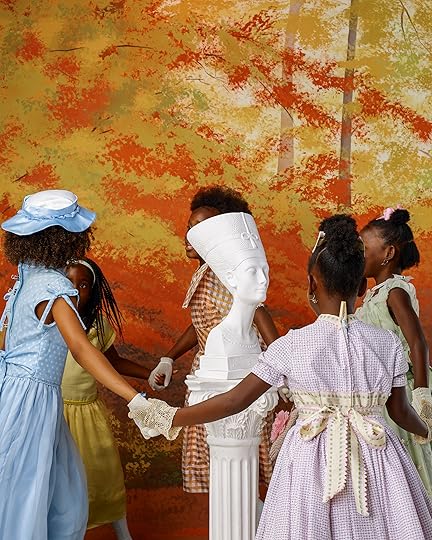 Awol Erizku, Love Is Bond (Young Queens), 2018–20
Awol Erizku, Love Is Bond (Young Queens), 2018–20Courtesy the artist
Awol Erizku: Mystic Parallax (2023)
Awol Erizku’s interdisciplinary practice references and reimagines African American and African visual culture, from hip-hop vernacular to Nefertiti, while nodding to traditions of spirituality and Surrealism. The 2023 volume Mystic Parallax is the first major monograph to trace the artist’s career. Spanning over ten years, the monograph blends together his studio practice with his work as an in-demand editorial photographer, including his conceptual portraits of cultural icons such as Solange, Amanda Gorman, and Michael B. Jordan.
Throughout his work, Erizku consistently questions and reimagines Western art, often by casting Black people in his contemporary reconstructions of canonical artworks. “I always think about my work as a constellation, and a new piece is just another star within the universe,” he asserts in his wide-ranging conversation with the curator Antwaun Sargent, included in the book. “This goes back to the idea of a continuum of the Black imagination. When it’s my turn, as an image maker, a visual griot, it is up to me to redefine a concept, give it a new tone, a new look, a new visual form.”
Advertisement
googletag.cmd.push(function () {
googletag.display('div-gpt-ad-1343857479665-0');
});
 James Barnor, Drum Cover Girl Erlin Ibreck, Kilburn, London, 1966
James Barnor, Drum Cover Girl Erlin Ibreck, Kilburn, London, 1966Courtesy the artist
As We Rise: Photography from the Black Atlantic (2021)
In 1997, Dr. Kenneth Montague founded the Wedge Collection in Toronto in an effort to acquire and exhibit work by artists of African descent. As We Rise features over one hundred works from the collection, bringing together artists from Canada, the Caribbean, Great Britain, the US, South America, and Africa in a timely exploration of Black identity on both sides of the Atlantic.
From Jamel Shabazz’s definitive street portraits to Lebohang Kganye’s blurring of self, mother, and family history in South Africa, As We Rise looks at multifaceted ideas of Black life through the lenses of community, identity, and power. As Teju Cole describes in his preface, “Too often in the larger culture, we see images of Black people in attitudes of despair, pain, or brutal isolation. As We Rise gently refuses that. It is not that people are always in an attitude of celebration—no, that would be a reverse but corresponding falsehood—but rather that they are present as human beings, credible, fully engaged in their world.”
Collect a special vinyl LP, As We Rise: Sounds from the Black Atlantic , featuring a celebratory collection of classic and contemporary Black music made throughout the diaspora.
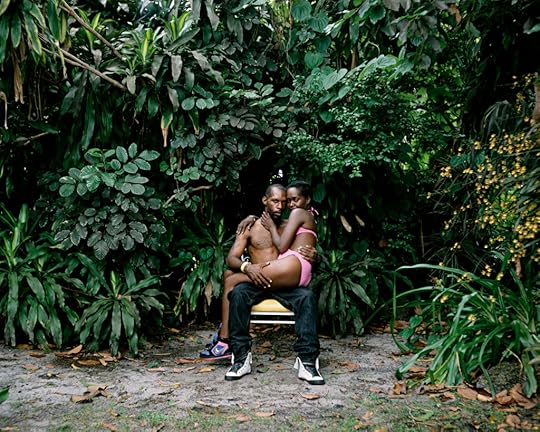 Deana Lawson, Oath, 2013
Deana Lawson, Oath, 2013Courtesy the artist
Deana Lawson: An Aperture Monograph (2018)
Deana Lawson has created a visionary language to describe identities through intimate portraiture and striking accounts of ceremonies and rituals. Using medium- and large-format cameras, Lawson works with models throughout the US, Caribbean, and Africa to construct arresting, highly structured, and deliberately theatrical scenes. Signature to Lawson’s work is an exquisite range of color and attention to detail—from the bedding and furniture in her domestic interiors to the lush plants and Edenic gardens that serve as dramatic backdrops.
Published in 2018, Deana Lawson: An Aperture Monograph was the first book by the acclaimed artist. In 2020, Lawson became the first photographer to be awarded the Hugo Boss Prize. Most recently, Lawson was the guest editor of Aperture’s Fall 2024 issue, “Arrhythmic Mythic Ra,” in which she curated a selection of artists past and present to explore the enigmatic nature of photography.
One of the most compelling photographers of her generation, Lawson portrays the personal and the powerful. “Outside a Lawson portrait you might be working three jobs, just keeping your head above water, struggling,” writes Zadie Smith in an essay for the book. “But inside her frame you are beautiful, imperious, unbroken, unfallen.”
Collect a limited edition of Deana Lawson: An Aperture Monograph, featuring a special slipcase and custom tipped-on C-print.
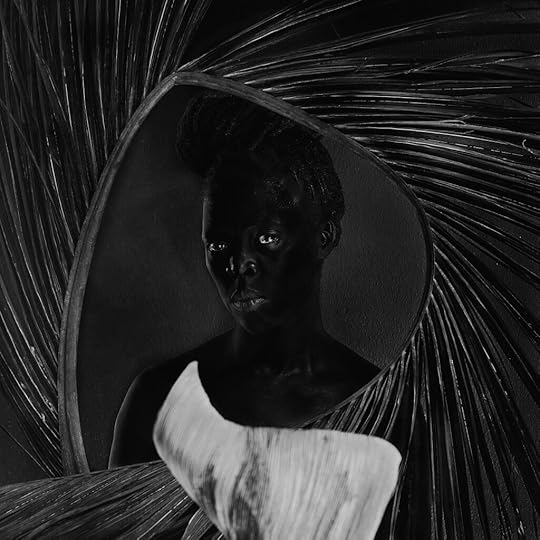 Zanele Muholi, Mihla IV, Port Edward, South Africa, 2020
Zanele Muholi, Mihla IV, Port Edward, South Africa, 2020Courtesy the artist
Zanele Muholi: Somnyama Ngonyama, Hail the Dark Lioness, Volume II (2024)
The South African artist Zanele Muholi is one of the most powerful visual activists of our time. Muholi first gained recognition for their 2006 series Faces and Phases that documents the LGBTQIA+ community, creating ambitiously bold portraits in an attempt to build a visual history and remedy Black queer erasure. From there, Muholi began to turn the camera inward, beginning a series of evocative self-portraits. Somnyama Ngonyama, Hail the Dark Lioness, Volume II (2024) is the follow-up to Muholi’s critically acclaimed first title featuring their self-portraits.
In their evocative self-portraits, Muholi explores and expands upon notions of Blackness, and the myriad possibilities of the self. Drawing on different materials or found objects referencing their environment, a specific event, or lived experience, Muholi boldly explores their own image and innate possibilities as a Black person in today’s global society, and speaks emphatically in response to contemporary and historical racisms. “I am producing this photographic document to encourage individuals in my community to be brave enough to occupy spaces—brave enough to create without fear of being vilified,” Muholi states in an interview from the 2018 volume. “To teach people about our history, to rethink what history is all about, to reclaim it for ourselves—to encourage people to use artistic tools such as cameras as weapons to fight back.”
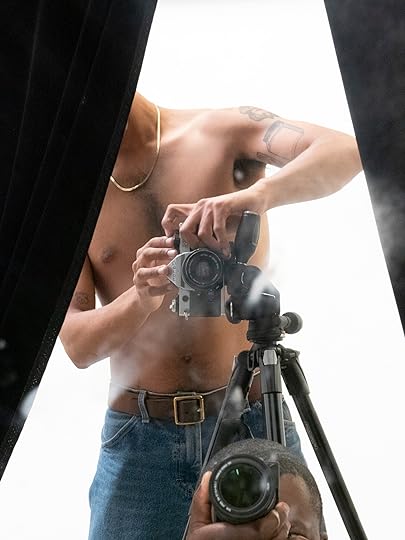 Paul Mpagi Sepuya, Drop Scene (_1030683), 2018
Paul Mpagi Sepuya, Drop Scene (_1030683), 2018Courtesy the artist
Paul Mpagi Sepuya: Dark Room A–Z (2024)
Paul Mpagi Sepuya’s photography is grounded in a collaborative, rhizomatic approach to his studio practice and portraiture. Through collage, layering, fragmentation, and mirror imagery, Sepuya encourages multivalent narrative readings of each image.
Four years after publishing the first widely available volume of Sepuya’s work, Aperture released Dark Room A–Z, a comprehensive monograph that dives into the thick network of references and the interconnected community of artists and subjects that he has interwoven throughout the images. The volume unpacks Sepuya’s Dark Room series (2016–21), reflecting on the methodologies, strategies, and points of interest behind this expansive body of work. Alongside Sepuya’s work is a range of writings by critics, curators, friends, and the artist. Dark Room A–Z serves as an iterative return and exhaustive manual to the strategies and generative ways of working that have informed Sepuya’s image-making, after nearly two decades of practice.
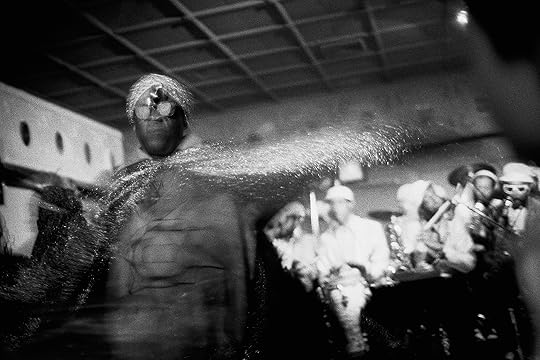 Ming Smith, Sun Ra Space II, New York, 1978
Ming Smith, Sun Ra Space II, New York, 1978© the artist
Ming Smith: An Aperture Monograph (2020)
Ming Smith’s poetic and experimental images are icons of twentieth-century Black American life. Smith began experimenting with photography as early as kindergarten, when she made pictures of her classmates with her parents’ Brownie camera. She went on to attend Howard University, Washington, DC, where she continued her practice, and eventually moved to New York in the 1970s. Smith supported herself by modeling for agencies like Wilhelmina, and around the same time, joined the Kamoinge Workshop. In 1979, Smith became the first Black woman photographer to have work acquired by the Museum of Modern Art, New York.
Throughout her career, Smith has photographed various forms of Black community and creativity—from mothers and children having an ordinary day in Harlem, to her photographic tribute to playwright August Wilson, to the majestic performance style of Sun Ra. Her trademark lyricism, distinctively blurred silhouettes, and dynamic street scenes established Smith as one of the greatest artist-photographers working today. As Yxta Maya Murray writes for the New Yorker, “Smith brings her passion and intellect to a remarkable body of photography that belongs in the canon for its wealth of ideas and its preservation of Black women’s lives during an age, much like today, when nothing could be taken for granted.”
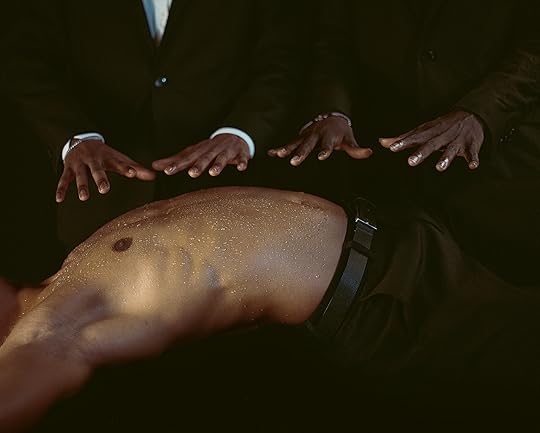 Shikeith, O’ my body, make of me always a man who questions!, 2020
Shikeith, O’ my body, make of me always a man who questions!, 2020Courtesy the artist
Shikeith: Notes towards Becoming a Spill (2022)
A visceral and haunting exploration of Black male vulnerability, joy, and spirituality, Notes towards Becoming a Spill is the first monograph by the acclaimed multimedia artist Shikeith. Following the lyrical artistic expressions of contemporary portraitists such as Deana Lawson, Paul Mpagi Sepuya, and Mickalene Thomas, Shikeith photographs men as they inhabit various states of meditation, prayer, and ecstasy.
In work he describes as “leaning into the uncanny,” the faces and bodies of Shikeith’s collaborators glisten with sweat (and tears) in a manifestation and evidence of desire. This ecstasy is what the critic Antwaun Sargent proclaims as “an ideal, a warm depiction that insists on concrete possibility for another world.” Notes towards Becoming a Spill redefines the idea of sacred space and positions a queer ethic identified by its investment in vulnerability, tenderness, and joy.
Collect a limited-edition screenprint by Shikeith.
See here to browse the full collection of featured titles.
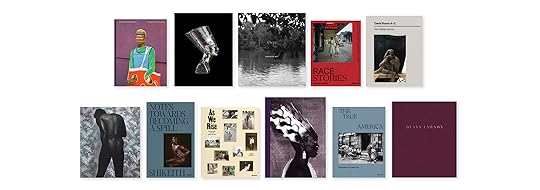 var container = ''; jQuery('#fl-main-content').find('.fl-row').each(function () { if (jQuery(this).find('.gutenberg-full-width-image-container').length) { container = jQuery(this); } }); if (container.length) { const fullWidthImageContainer = jQuery('.gutenberg-full-width-image-container'); const fullWidthImage = jQuery('.gutenberg-full-width-image img'); const watchFullWidthImage = _.throttle(function() { const containerWidth = Math.abs(jQuery(container).css('width').replace('px', '')); const containerPaddingLeft = Math.abs(jQuery(container).css('padding-left').replace('px', '')); const bodyWidth = Math.abs(jQuery('body').css('width').replace('px', '')); const marginLeft = ((bodyWidth - containerWidth) / 2) + containerPaddingLeft; jQuery(fullWidthImageContainer).css('position', 'relative'); jQuery(fullWidthImageContainer).css('marginLeft', -marginLeft + 'px'); jQuery(fullWidthImageContainer).css('width', bodyWidth + 'px'); jQuery(fullWidthImage).css('width', bodyWidth + 'px'); }, 100); jQuery(window).on('load resize', function() { watchFullWidthImage(); }); const observer = new MutationObserver(function(mutationsList, observer) { for(var mutation of mutationsList) { if (mutation.type == 'childList') { watchFullWidthImage();//necessary because images dont load all at once } } }); const observerConfig = { childList: true, subtree: true }; observer.observe(document, observerConfig); }
var container = ''; jQuery('#fl-main-content').find('.fl-row').each(function () { if (jQuery(this).find('.gutenberg-full-width-image-container').length) { container = jQuery(this); } }); if (container.length) { const fullWidthImageContainer = jQuery('.gutenberg-full-width-image-container'); const fullWidthImage = jQuery('.gutenberg-full-width-image img'); const watchFullWidthImage = _.throttle(function() { const containerWidth = Math.abs(jQuery(container).css('width').replace('px', '')); const containerPaddingLeft = Math.abs(jQuery(container).css('padding-left').replace('px', '')); const bodyWidth = Math.abs(jQuery('body').css('width').replace('px', '')); const marginLeft = ((bodyWidth - containerWidth) / 2) + containerPaddingLeft; jQuery(fullWidthImageContainer).css('position', 'relative'); jQuery(fullWidthImageContainer).css('marginLeft', -marginLeft + 'px'); jQuery(fullWidthImageContainer).css('width', bodyWidth + 'px'); jQuery(fullWidthImage).css('width', bodyWidth + 'px'); }, 100); jQuery(window).on('load resize', function() { watchFullWidthImage(); }); const observer = new MutationObserver(function(mutationsList, observer) { for(var mutation of mutationsList) { if (mutation.type == 'childList') { watchFullWidthImage();//necessary because images dont load all at once } } }); const observerConfig = { childList: true, subtree: true }; observer.observe(document, observerConfig); }
11 Photobooks That Celebrate Black Voices and History
 LaToya Ruby Frazier, Grandma Ruby and Me, 2005
LaToya Ruby Frazier, Grandma Ruby and Me, 2005Courtesy the artist and Gladstone Gallery
Race Stories: Essays on the Power of Images, by Maurice Berger (2024)
In Race Stories: Essays on the Power of Images, the late cultural historian Maurice Berger explores the intersections of photography, race, and visual culture. Between 2012 and 2019, Berger first shared these essays in a monthly column on the New York Times Lens blog. Copublished by Aperture and the New York Times, this volume marks the first title in Aperture’s Vision & Justice Book Series, created and coedited by Drs. Sarah E. Lewis, Leigh Raiford, and Deborah Willis, which reexamines and redresses historical narratives of photography, race, and justice.
Edited by Marvin Heiferman, this anthology brings together seventy-one essays that examine the transformational role photography plays in shaping ideas and attitudes about race, and how photographic images have been instrumental in both perpetuating and combating racial stereotypes. From pivotal moments in American history to the ways in which images by LaToya Ruby Frazier, Gordon Parks, Jamel Shabazz, Pete Souza help us see the world anew, Race Stories showcases Berger’s lifelong endeavor to distill complex ideas about racial equity. As Henry Louis Gates, Jr., writes in the book’s foreword: “This collection establishes not only Maurice Berger’s place in the history of the criticism of photography but also his role as a social philosopher determined to underscore, essay by essay, all that unites us as human beings.”
 Dawoud Bey, Irrigation Ditch, 2019
Dawoud Bey, Irrigation Ditch, 2019Courtesy the artist
Dawoud Bey: Elegy (2023)
In Elegy, Dawoud Bey focuses on the landscape to create a portrait of the early African American presence in the United States. Renowned for his Harlem street scenes and expressive portraits, this volume marks a continuation of Bey’s ongoing work exploring African American history. Copublished by Aperture and the Virginia Museum of Fine Arts, Elegy focuses on three of Bey’s landscape series—Night Coming Tenderly, Black (2017); In This Here Place (2021); and Stony the Road (2023)—shedding a light on the deep historical memory still embedded in the geography of the US.
Bey takes viewers to the historic Richmond Slave Trail in Virginia, where Africans were marched onto auction blocks; to the plantations of Louisiana, where they labored; and along the last stages of the Underground Railroad in Ohio, where fugitives sought self-emancipation. By interweaving these bodies of work into an elegy in three movements, Bey not only evokes history but retells it through historically grounded images that challenge viewers to go beyond seeing and imagine lived experiences. “This is ancestor work,” Bey tells the New York Times. “Stepping outside the art context, the project context, this is the work of keeping our ancestors present in the contemporary conversation.”
 Arielle Bobb-Willis, Austin, 2020
Arielle Bobb-Willis, Austin, 2020Courtesy the artist
Arielle Bobb-Willis: Keep the Kid Alive (2024)
Born in 1994 in New York, Arielle Bobb-Willis first started to experiment with photography at the age of fourteen, when she was gifted an old Nikon N80 film camera by her high school history teacher after her family relocated to South Carolina. Since then, Bobb-Willis has become a rising photographer, having shot commissions for a range of magazines and fashion brands including Vogue, the New York Times, Vanity Fair, Nike, Hermès, and more. In 2024, Aperture published the artist’s first monograph, Keep the Kid Alive. Previously, Aperture had featured Bobb-Willis’s work in the The New Black Vanguard (2017), which highlights the work of fifteen contemporary Black photographers rethinking the possibilities of representation.
In Keep the Kid Alive, Bobb-Willis invites audiences into a brightly imaginative world, filled with dynamic colors, gestures, and unusual poses of the artist’s own creation. Transforming the streets of New Orleans, New York, and Los Angeles into lush backdrops for her wonderfully surreal tableaux, Bobb-Willis makes unforgettable images that expand the genres of fashion and art photography. As Bobb-Willis notes in an interview from the book, “Photography is, and will always be, a daily practice of falling in love with as many things as I can.”
Collect a limited-edition print by Arielle-Bobb Willis from Keep the Kid Alive.
 Ernest Cole, Untitled, New York City, 1968–71
Ernest Cole, Untitled, New York City, 1968–71© The Ernest Cole Family Trust
Ernest Cole: The True America (2024)
After fleeing South Africa to publish his landmark book House of Bondage in 1967 (reissued by Aperture in 2022) on the horrors of apartheid, Ernest Cole became a “banned person” and resettled in New York. Supported by a grant from the Ford Foundation, Cole photographed the city’s streets extensively, chronicling daily life in Harlem and around Manhattan. In 1968 he traveled across the country to cities including Chicago, Cleveland, Memphis, Atlanta, Los Angeles, and Washington, DC, as well as to rural areas of the South, capturing the activism and emotional tenor in the months leading up to and just after the assassination of Martin Luther King Jr. These photographs reflect both the newfound freedom Cole experienced in the US and the photographer’s sharp eye for inequality as he became increasingly disillusioned by the systemic racism he witnessed.
Cole released very few images from this body of work while he was alive. Thought to be lost entirely, the negatives of Cole’s American pictures resurfaced in Sweden in 2017 and were returned to the Ernest Cole Family Trust. The True America marks the first time these photographs have been brought together in a major publication. This trove of rediscovered work acts as a vital window into American society and redefines the scope of Cole’s photographic work.
Collect a limited-edition print from Ernest Cole: The True America. An exhibition of The True America is on view at the Minneapolis Institute of Art through June 22, 2025.
 Awol Erizku, Love Is Bond (Young Queens), 2018–20
Awol Erizku, Love Is Bond (Young Queens), 2018–20Courtesy the artist
Awol Erizku: Mystic Parallax (2023)
Awol Erizku’s interdisciplinary practice references and reimagines African American and African visual culture, from hip-hop vernacular to Nefertiti, while nodding to traditions of spirituality and Surrealism. The 2023 volume Mystic Parallax is the first major monograph to trace the artist’s career. Spanning over ten years, the monograph blends together his studio practice with his work as an in-demand editorial photographer, including his conceptual portraits of cultural icons such as Solange, Amanda Gorman, and Michael B. Jordan.
Throughout his work, Erizku consistently questions and reimagines Western art, often by casting Black people in his contemporary reconstructions of canonical artworks. “I always think about my work as a constellation, and a new piece is just another star within the universe,” he asserts in his wide-ranging conversation with the curator Antwaun Sargent, included in the book. “This goes back to the idea of a continuum of the Black imagination. When it’s my turn, as an image maker, a visual griot, it is up to me to redefine a concept, give it a new tone, a new look, a new visual form.”
Advertisement
googletag.cmd.push(function () {
googletag.display('div-gpt-ad-1343857479665-0');
});
 James Barnor, Drum Cover Girl Erlin Ibreck, Kilburn, London, 1966
James Barnor, Drum Cover Girl Erlin Ibreck, Kilburn, London, 1966Courtesy the artist
As We Rise: Photography from the Black Atlantic (2021)
In 1997, Dr. Kenneth Montague founded the Wedge Collection in Toronto in an effort to acquire and exhibit work by artists of African descent. As We Rise features over one hundred works from the collection, bringing together artists from Canada, the Caribbean, Great Britain, the US, South America, and Africa in a timely exploration of Black identity on both sides of the Atlantic.
From Jamel Shabazz’s definitive street portraits to Lebohang Kganye’s blurring of self, mother, and family history in South Africa, As We Rise looks at multifaceted ideas of Black life through the lenses of community, identity, and power. As Teju Cole describes in his preface, “Too often in the larger culture, we see images of Black people in attitudes of despair, pain, or brutal isolation. As We Rise gently refuses that. It is not that people are always in an attitude of celebration—no, that would be a reverse but corresponding falsehood—but rather that they are present as human beings, credible, fully engaged in their world.”
Collect a special vinyl LP, As We Rise: Sounds from the Black Atlantic , featuring a celebratory collection of classic and contemporary Black music made throughout the diaspora.
 Deana Lawson, Oath, 2013
Deana Lawson, Oath, 2013Courtesy the artist
Deana Lawson: An Aperture Monograph (2018)
Deana Lawson has created a visionary language to describe identities through intimate portraiture and striking accounts of ceremonies and rituals. Using medium- and large-format cameras, Lawson works with models throughout the US, Caribbean, and Africa to construct arresting, highly structured, and deliberately theatrical scenes. Signature to Lawson’s work is an exquisite range of color and attention to detail—from the bedding and furniture in her domestic interiors to the lush plants and Edenic gardens that serve as dramatic backdrops.
Published in 2018, Deana Lawson: An Aperture Monograph was the first book by the acclaimed artist. In 2020, Lawson became the first photographer to be awarded the Hugo Boss Prize. Most recently, Lawson was the guest editor of Aperture’s Fall 2024 issue, “Arrhythmic Mythic Ra,” in which she curated a selection of artists past and present to explore the enigmatic nature of photography.
One of the most compelling photographers of her generation, Lawson portrays the personal and the powerful. “Outside a Lawson portrait you might be working three jobs, just keeping your head above water, struggling,” writes Zadie Smith in an essay for the book. “But inside her frame you are beautiful, imperious, unbroken, unfallen.”
Collect a limited edition of Deana Lawson: An Aperture Monograph, featuring a special slipcase and custom tipped-on C-print.
 Zanele Muholi, Mihla IV, Port Edward, South Africa, 2020
Zanele Muholi, Mihla IV, Port Edward, South Africa, 2020Courtesy the artist
Zanele Muholi: Somnyama Ngonyama, Hail the Dark Lioness, Volume II (2024)
The South African artist Zanele Muholi is one of the most powerful visual activists of our time. Muholi first gained recognition for their 2006 series Faces and Phases that documents the LGBTQIA+ community, creating ambitiously bold portraits in an attempt to build a visual history and remedy Black queer erasure. From there, Muholi began to turn the camera inward, beginning a series of evocative self-portraits. Somnyama Ngonyama, Hail the Dark Lioness, Volume II (2024) is the follow-up to Muholi’s critically acclaimed first title featuring their self-portraits.
In their evocative self-portraits, Muholi explores and expands upon notions of Blackness, and the myriad possibilities of the self. Drawing on different materials or found objects referencing their environment, a specific event, or lived experience, Muholi boldly explores their own image and innate possibilities as a Black person in today’s global society, and speaks emphatically in response to contemporary and historical racisms. “I am producing this photographic document to encourage individuals in my community to be brave enough to occupy spaces—brave enough to create without fear of being vilified,” Muholi states in an interview from the 2018 volume. “To teach people about our history, to rethink what history is all about, to reclaim it for ourselves—to encourage people to use artistic tools such as cameras as weapons to fight back.”
 Paul Mpagi Sepuya, Drop Scene (_1030683), 2018
Paul Mpagi Sepuya, Drop Scene (_1030683), 2018Courtesy the artist
Paul Sepuya: Dark Room A–Z (2024)
Paul Mpagi Sepuya’s photography is grounded in a collaborative, rhizomatic approach to his studio practice and portraiture. Through collage, layering, fragmentation, and mirror imagery, Sepuya encourages multivalent narrative readings of each image.
Four years after publishing the first widely available volume of Sepuya’s work, Aperture released Dark Room A–Z, a comprehensive monograph that dives into the thick network of references and the interconnected community of artists and subjects that he has interwoven throughout the images. The volume unpacks Sepuya’s Dark Room series (2016–21), reflecting on the methodologies, strategies, and points of interest behind this expansive body of work. Alongside Sepuya’s work is a range of writings by critics, curators, friends, and the artist. Dark Room A–Z serves as an iterative return and exhaustive manual to the strategies and generative ways of working that have informed Sepuya’s image-making, after nearly two decades of practice.
 Ming Smith, Sun Ra Space II, New York, 1978
Ming Smith, Sun Ra Space II, New York, 1978© the artist
Ming Smith: An Aperture Monograph (2020)
Ming Smith’s poetic and experimental images are icons of twentieth-century Black American life. Smith began experimenting with photography as early as kindergarten, when she made pictures of her classmates with her parents’ Brownie camera. She went on to attend Howard University, Washington, DC, where she continued her practice, and eventually moved to New York in the 1970s. Smith supported herself by modeling for agencies like Wilhelmina, and around the same time, joined the Kamoinge Workshop. In 1979, Smith became the first Black woman photographer to have work acquired by the Museum of Modern Art, New York.
Throughout her career, Smith has photographed various forms of Black community and creativity—from mothers and children having an ordinary day in Harlem, to her photographic tribute to playwright August Wilson, to the majestic performance style of Sun Ra. Her trademark lyricism, distinctively blurred silhouettes, and dynamic street scenes established Smith as one of the greatest artist-photographers working today. As Yxta Maya Murray writes for the New Yorker, “Smith brings her passion and intellect to a remarkable body of photography that belongs in the canon for its wealth of ideas and its preservation of Black women’s lives during an age, much like today, when nothing could be taken for granted.”
 Shikeith, O’ my body, make of me always a man who questions!, 2020
Shikeith, O’ my body, make of me always a man who questions!, 2020Courtesy the artist
Shikeith: Notes towards Becoming a Spill (2022)
A visceral and haunting exploration of Black male vulnerability, joy, and spirituality, Notes towards Becoming a Spill is the first monograph by the acclaimed multimedia artist Shikeith. Following the lyrical artistic expressions of contemporary portraitists such as Deana Lawson, Paul Mpagi Sepuya, and Mickalene Thomas, Shikeith photographs men as they inhabit various states of meditation, prayer, and ecstasy.
In work he describes as “leaning into the uncanny,” the faces and bodies of Shikeith’s collaborators glisten with sweat (and tears) in a manifestation and evidence of desire. This ecstasy is what the critic Antwaun Sargent proclaims as “an ideal, a warm depiction that insists on concrete possibility for another world.” Notes towards Becoming a Spill redefines the idea of sacred space and positions a queer ethic identified by its investment in vulnerability, tenderness, and joy.
Collect a limited-edition screenprint by Shikeith.
See here to browse the full collection of featured titles.
 var container = ''; jQuery('#fl-main-content').find('.fl-row').each(function () { if (jQuery(this).find('.gutenberg-full-width-image-container').length) { container = jQuery(this); } }); if (container.length) { const fullWidthImageContainer = jQuery('.gutenberg-full-width-image-container'); const fullWidthImage = jQuery('.gutenberg-full-width-image img'); const watchFullWidthImage = _.throttle(function() { const containerWidth = Math.abs(jQuery(container).css('width').replace('px', '')); const containerPaddingLeft = Math.abs(jQuery(container).css('padding-left').replace('px', '')); const bodyWidth = Math.abs(jQuery('body').css('width').replace('px', '')); const marginLeft = ((bodyWidth - containerWidth) / 2) + containerPaddingLeft; jQuery(fullWidthImageContainer).css('position', 'relative'); jQuery(fullWidthImageContainer).css('marginLeft', -marginLeft + 'px'); jQuery(fullWidthImageContainer).css('width', bodyWidth + 'px'); jQuery(fullWidthImage).css('width', bodyWidth + 'px'); }, 100); jQuery(window).on('load resize', function() { watchFullWidthImage(); }); const observer = new MutationObserver(function(mutationsList, observer) { for(var mutation of mutationsList) { if (mutation.type == 'childList') { watchFullWidthImage();//necessary because images dont load all at once } } }); const observerConfig = { childList: true, subtree: true }; observer.observe(document, observerConfig); }
var container = ''; jQuery('#fl-main-content').find('.fl-row').each(function () { if (jQuery(this).find('.gutenberg-full-width-image-container').length) { container = jQuery(this); } }); if (container.length) { const fullWidthImageContainer = jQuery('.gutenberg-full-width-image-container'); const fullWidthImage = jQuery('.gutenberg-full-width-image img'); const watchFullWidthImage = _.throttle(function() { const containerWidth = Math.abs(jQuery(container).css('width').replace('px', '')); const containerPaddingLeft = Math.abs(jQuery(container).css('padding-left').replace('px', '')); const bodyWidth = Math.abs(jQuery('body').css('width').replace('px', '')); const marginLeft = ((bodyWidth - containerWidth) / 2) + containerPaddingLeft; jQuery(fullWidthImageContainer).css('position', 'relative'); jQuery(fullWidthImageContainer).css('marginLeft', -marginLeft + 'px'); jQuery(fullWidthImageContainer).css('width', bodyWidth + 'px'); jQuery(fullWidthImage).css('width', bodyWidth + 'px'); }, 100); jQuery(window).on('load resize', function() { watchFullWidthImage(); }); const observer = new MutationObserver(function(mutationsList, observer) { for(var mutation of mutationsList) { if (mutation.type == 'childList') { watchFullWidthImage();//necessary because images dont load all at once } } }); const observerConfig = { childList: true, subtree: true }; observer.observe(document, observerConfig); }
February 7, 2025
Barbara Probst’s Points of View
Twenty-five years ago, the German-born photographer Barbara Probst ascended a Midtown Manhattan high-rise, arranged a dozen cameras on tripods, and, at 10:47 p.m., leaped across the rooftop as an assistant triggered the shutters via a radio-controlled release system. The resulting grid of black-and-white and color images, a cross between Henri Cartier-Bresson and Michelangelo Antonioni, inaugurated the artist’s Exposures series (2000–ongoing), whose entries each consist of two or more photographs of the same scene, captured simultaneously at different perspectives and time-stamped with Teutonic precision, so that a single second shatters into a puzzle impossible to solve. The Exposures—which span landscapes, still lifes, fashion shoots, portraits, and street photography—may be read as philosophical treatises, each one coolly oppugning their medium’s purchase on the Truth. But they’re also beautiful, suffused with a surprising spontaneity and forensic mystery.
Below, the photographer discusses her work in the context of Barbara Probst: Subjective Evidence, a survey exhibition on view through February 9 at Cincinnati’s Contemporary Arts Center, which opened last November as part of the city’s seventh FotoFocus Biennial, Backstories.
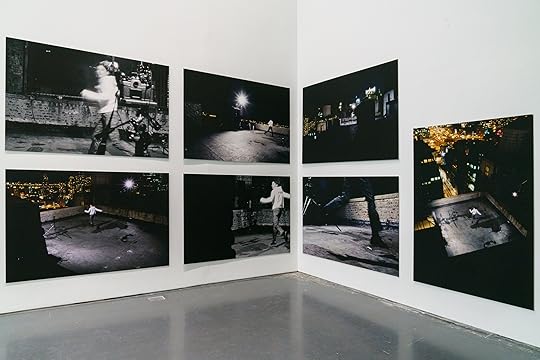 Installation view of Barbara Probst, Exposure #1 2000, 2002, at the Cincinnati Contemporary Arts Center, 2024
Installation view of Barbara Probst, Exposure #1 2000, 2002, at the Cincinnati Contemporary Arts Center, 2024Photograph by Jacob Drabik
Zack Hatfield: Zaha Hadid’s Contemporary Arts Center is so perfect for your photographs. The building has a kind of baroque interplay of spatial compression and expansion that we find in your work too. What was it like making the exhibition here?
Barbara Probst: I came here a year ago with Kevin Moore, the curator of the exhibition, to look at the space. I immediately liked the architecture, because of all these different vantage points and the possibilities of creating relationships between the works in it. My assistant made a model of the space to see how the works can be placed in relation to each other. And it was a very difficult model to build. Hardly any ninety-degree angles.
Hatfield: You also make models for your actual photoshoots as well, right?
Probst: Yeah, or drawings. Sometimes I make clay figures of the people I’m photographing to better imagine how they relate to each other in the shoot and to figure out the angles and viewpoints of the cameras. Shooting with several cameras simultaneously is a complex procedure and needs to be prepared very well.
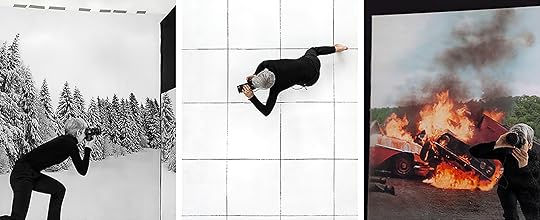 Barbara Probst, Exposure #185: Munich, Nederlingerstrasse 68, 04.21.23, 2:35 p.m., 2023
Barbara Probst, Exposure #185: Munich, Nederlingerstrasse 68, 04.21.23, 2:35 p.m., 2023Hatfield: People associate your exposures with meticulous orchestration and preparation, but there’s also a lot of improvisation that goes into it.
Probst: Sometimes I feel like a film director with all the details of a scene and all the viewpoints of the cameras in my mind before the shoot. Only when a shoot is planned and set up very accurately can I allow chance and improvisation. And often these unforeseeable changes add something really interesting to the pictures that I couldn’t have envisioned beforehand.
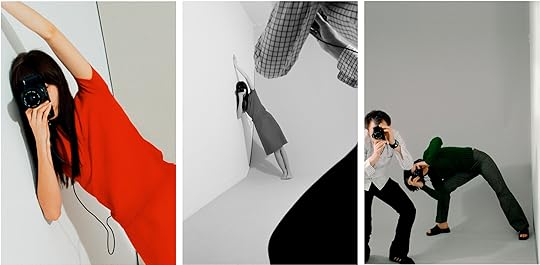 Barbara Probst, Exposure #32: N.Y.C., 249 W. 34th Street, 01.02.05, 5:04 p.m., 2005
Barbara Probst, Exposure #32: N.Y.C., 249 W. 34th Street, 01.02.05, 5:04 p.m., 2005Hatfield: Is there an example of a work in this show that turned out differently than you originally envisioned it?
Probst: Most of them are close to my conception. You need to realize that I hardly ever look through one of the viewfinders during a shoot. Usually, I find a position hidden from the cameras, and from there I release the shutters simultaneously. That’s why my control is limited. Envisioning a shoot and the outcome of the images is one thing—the realities during a shoot, another. For example, Exposure #106 was a shoot on the street with several models inside a building linked to an unstaged scene with a yellow cab on the street downstairs. The shoot was made with twelve cameras. I conceived the twelve images very precisely beforehand, but there was much going on in the shoot that was beyond my control. But even in a shoot like this, I came very close to the images I had in my mind. The works made in the studio, like the close-ups and still lifes, are much more controllable and calculable. It’s a very different way of working for me.
Hatfield: How do you see your work’s relationship to narrative?
Probst: To look simultaneously from different perspectives means to give up the single point of view to which we’re accustomed. It also means no longer believing that the narrative emanating from that single viewpoint is reliable or truthful. I feel that my work actually has a lot to do with life. We all are here on this planet at the same time, and we all look at this world in very different ways. What I have learned from my work is that instead of choosing one way of seeing or another, it’s much more realistic to acknowledge many. In today’s world, this might sound disconcerting, but it can also be a relief to recognize that we don’t really know.
 Barbara Probst, Exposure #180, Munich, Nederlingerstrasse 68, 09.11.22, 3:40 p.m., 2022
Barbara Probst, Exposure #180, Munich, Nederlingerstrasse 68, 09.11.22, 3:40 p.m., 2022 Barbara Probst, Exposure #87: N.Y.C., 401 Broadway, 03.15.11, 4:22 p.m., 2011
Barbara Probst, Exposure #87: N.Y.C., 401 Broadway, 03.15.11, 4:22 p.m., 2011Hatfield: There’s a fascinating relationality that emerges through this distinct triangulation of photographer, model, and viewer. Your pictures ask a lot of the viewers’ imagination.
Probst: Yes, in some works, I try to draw the viewer into the images by creating this kind of triangulation. For example, in Exposure #87, there’s the space in which the model is located; there’s the space of the photographer in the backdrop on the wall of the studio, and there’s the “real” space of the viewer, all of which overlap and interact.
Hatfield: I’m interested in your beginnings as a sculptor. I know you were inspired early on by Rodin’s public statue The Burghers of Calais (1884–95), specifically how the figures are arranged nonhierarchically.
Probst: I chose a very classical training as a sculptor, which included daily nude modeling and drawing in the first year. Then I made abstract sculptures and later sculptures that included photography and finally installations containing sculptures and photographs before I dived deeply and exclusively into the medium of photography by starting the Exposure series in January 2000. I still feel that my work is very sculptural. Looking at something from different viewpoints is a sculptural interest. The Exposures can create a spatial impression in the mind of the viewer. The nudes, for example, are the works coming closest to this impression. I look at a nude from different angles, just like a sculptor while modeling one. These nude exposures are a nod to the classical genre of nudes, but they also break with it at the same time by reflecting the making of the pictures by showing all the cameras shooting the nude.
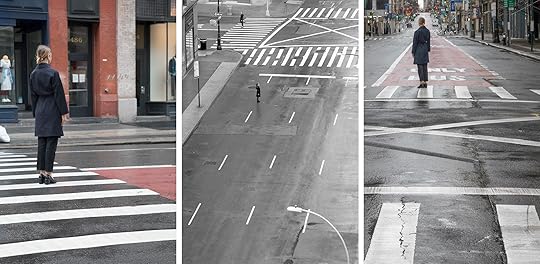 Barbara Probst, Exposure #152: N.Y.C., Broadway & Broome Street, 04.18.20, 10:46 a.m., 2020
Barbara Probst, Exposure #152: N.Y.C., Broadway & Broome Street, 04.18.20, 10:46 a.m., 2020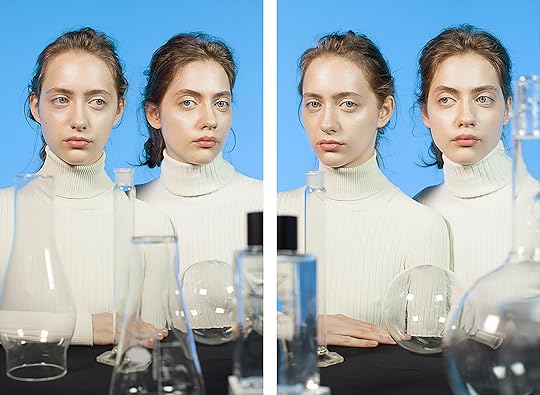 Barbara Probst, Exposure #124, Brooklyn, Industria Studios, 39 South 5th St, 04.13.17, 10:39 a.m., 2017
Barbara Probst, Exposure #124, Brooklyn, Industria Studios, 39 South 5th St, 04.13.17, 10:39 a.m., 2017Hatfield: The museum’s wall text draws a connection between the multiple perspectives at play in your work and this idea of empathy—of trying to share the experiences of other people. Yet I feel as though your work dramatizes the limitations of knowing other people. Is your work about trying to experience the world from other peoples’ viewpoints?
Probst: You said it beautifully: It dramatizes the limitation of knowing other people. The limitation of knowing how they see the world. Having said that, I’m also interested in empathy, which is about trying to inhabit other points of view. Which requires imagination.
Hatfield: You don’t call your photographs portraits, but close-ups.
Probst: There are works of mine that refer to the genre of portraiture, but they aren’t portraits, because my work is never about the people, their character, or their personality. It’s the relationship between them and the viewer I am interested in, the back and forth of gazes—the gaze of the protagonists at the viewer and vice versa. For example, in Exposure #124, two women look at two different cameras. When you stand in front of the images, the two viewpoints of the cameras merge into one in your eyes. The viewer’s otherwise all-so-certain point of view is in question here.
Hatfield: Throughout the show, it’s remarkable how the subtlest change to an angle can completely transform a composition and its emotional content.
Probst: Often a slight difference in viewpoint can make you see a completely different image, a completely different narrative. Like Exposure #48, the cameras weren’t far apart. But in one image, she seems to be very present and aware of being photographed, and in the other image, the mood is completely different. She looks dreamy and deep in thought.
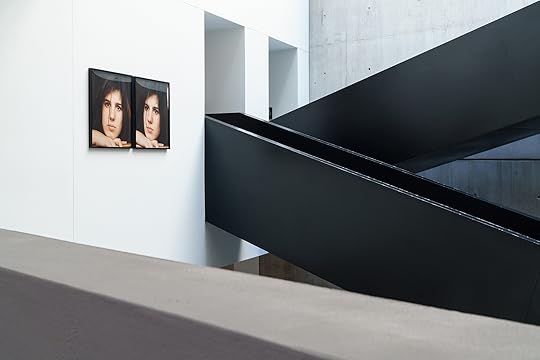 Installation view of Barbara Probst: Subjective Evidence, at the Cincinnati Contemporary Arts Center, 2024
Installation view of Barbara Probst: Subjective Evidence, at the Cincinnati Contemporary Arts Center, 2024Photograph by Jacob Drabik
 Barbara Probst, Exposure #48: Munich, Minerviusstrasse 11, 01.06.07, 3:17 p.m., 2007
Barbara Probst, Exposure #48: Munich, Minerviusstrasse 11, 01.06.07, 3:17 p.m., 2007All photographs courtesy the artist
Hatfield: Has your understanding of your own work changed in the almost twenty-five years since you did the first Exposure? Social media has enabled this sort of global simultaneity to accelerate at an unprecedented scale, and the idea of photographic truth has been pretty thoroughly vitiated.
Probst: It certainly has changed over the years. I started out being very conceptual. My interest in the relationship between photography and reality compelled me to conceive Exposure #1 and many other series afterward. Twenty-five years ago, this was a subject less questioned. Today, photography still has a tremendous influence on our subconscious as well as our conscious mind. This issue is inherent to my work, but it moved into the background over the years. Other aspects within the principle of simultaneity emerged, and I immersed myself in different photographic genres. And in more recent years, there’s more playfulness, and often there are references to painting. The still lifes, for example.
Hatfield: You’ve mined this concept for so long without exhausting its potential. You’ve been able to breathe new life into it through what you describe as tropes or clichés.
Probst: Thankfully yes. Exposure #1 is the base of all these works. After I finished it, I knew that there was much more to explore. I do have challenging phases of reflection and research, but usually I emerge refreshed, with new ideas. I’m currently occupied with new work that explores a field I haven’t entered before. But since I’m still in the middle of making it, I don’t want to say too much.
Barbara Probst: Subjective Evidence is on view through February 9 at the Cincinnati Center for Contemporary Art.
February 5, 2025
A Record of Exile from Syria
“When I left Syria, I lost all of my images from my phone,” said Sara Kontar, a photographer and filmmaker, speaking to me last month from Paris, where she has lived since 2016. An architecture student who had abruptly dropped her studies, Kontar arrived in France from Damascus via Turkey when she was nineteen years old. “During the journey, I was in Turkey, and I spoke to my father,” Kontar said. “He had gone through something similar.” Decades earlier, Kontar’s father had left Syria and returned. He stressed to his daughter the need for her to document what was happening to her, and also what was happening to Syria as a whole. She did, but then all the pictures she had taken disappeared when the memory in her phone was erased.
 Sara Kontar, “Travel Document for refugees allow to enter all countries except: Syria.” As a refugee you had to give up your passport and replace it with a “Travel Document for Refugee,” from the series Therefore, I Cut (2023)
Sara Kontar, “Travel Document for refugees allow to enter all countries except: Syria.” As a refugee you had to give up your passport and replace it with a “Travel Document for Refugee,” from the series Therefore, I Cut (2023) 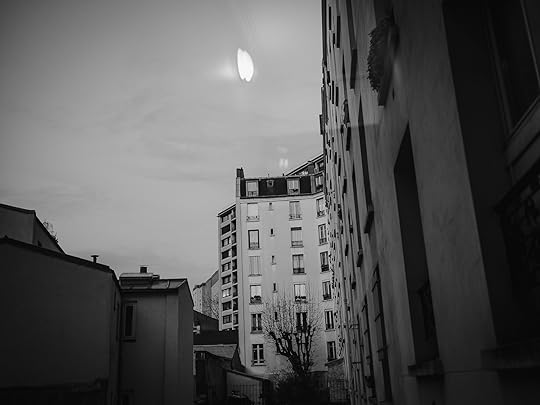 Sara Kontar, A view from our home in Paris, 2023
Sara Kontar, A view from our home in Paris, 2023 That journey had been hard, and in a way, Kontar was relieved not to have any visual reminders of it. But she remembered it, dreamed about it, and those images started to haunt her. It turned out that making new images, not casual snapshots with her phone but more planned-out photographs with a camera, helped ease her mind. “Since I was young, I wanted a camera, but it was really expensive, and I couldn’t afford it,” Kontar recalled. In Paris, she went to art school and studied animation. A classmate was selling her camera. “It was cheap, so I bought it,” Kontar said, adding with a laugh, “I didn’t choose photography. It chose me.”
 Sara Kontar, “If you weren’t here I would have really felt exiled.” My mother and her two friends, from the series Therefore, I Cut (2023)
Sara Kontar, “If you weren’t here I would have really felt exiled.” My mother and her two friends, from the series Therefore, I Cut (2023) 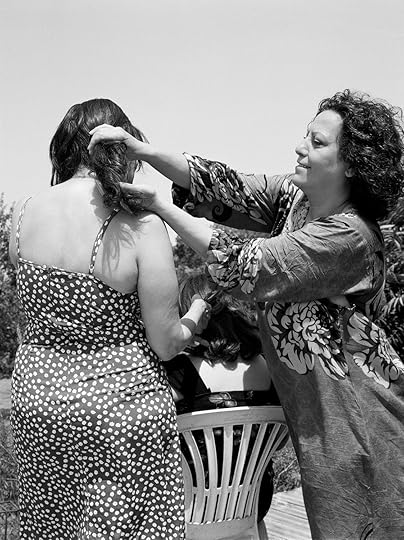
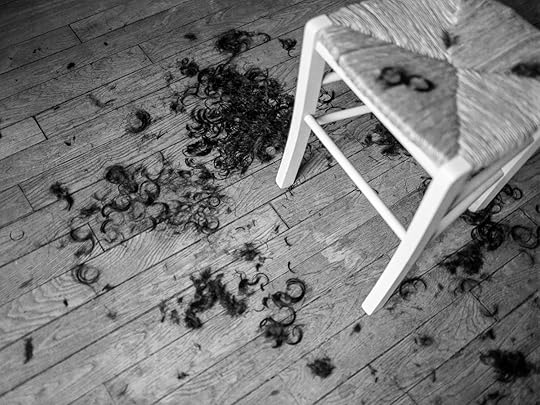 Sara Kontar, Someone told me that we carry memories of the past in our hair, so I asked my mother to cut it all, from the series Therefore, I Cut (2023)
Sara Kontar, Someone told me that we carry memories of the past in our hair, so I asked my mother to cut it all, from the series Therefore, I Cut (2023) 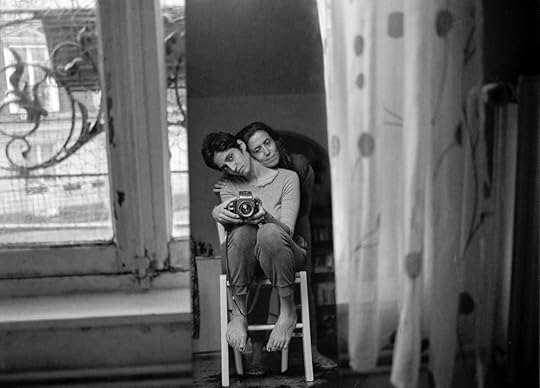 Sara Kontar, An auto-portrait with my mother after she cut my hair, from the series Therefore, I Cut (2023)
Sara Kontar, An auto-portrait with my mother after she cut my hair, from the series Therefore, I Cut (2023) Kontar’s body of work—across several different series of archival collages, documentary photographs, and experimental films—returns again and again to the question of exile, not only as a metaphorical space, or a set of lived experiences, but also as an adversary, as a tangled ball of bureaucratic red tape. Therefore, I Cut (2023) is both a collection of portraits and still lifes—hands holding a pair of scissors, two passports on a bed—and an unfolding narrative about a group of women who find everyday trust in each other. Them Syrians (2024–ongoing) chronicles the tangled relations between Lebanon and Syria as they play out among the old stones and historical scars of a mountain village.
In Syria, the regime of Bashar al-Assad, like that of his father before him, was explicitly built to fend off coups. The prison system, the many layers of intelligence services, the brutal structures of an authoritarian state were all constructed to absorb, co-opt, diminish, and defeat any effort to overthrow the government. When protests swept across the Arab world fourteen years ago, unleashing all kinds of hopes and dreams for a better future, Syria was the rocky shore on which those aspirations crashed, deformed themselves, and died.
Advertisement
googletag.cmd.push(function () {
googletag.display('div-gpt-ad-1343857479665-0');
});
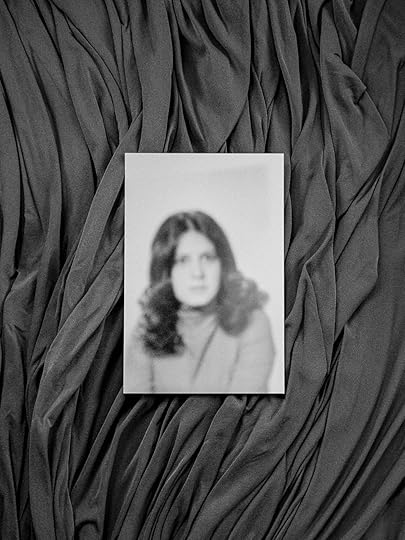 Sara Kontar, The blurry portrait of Majeda, from the series Therefore, I Cut (2023)
Sara Kontar, The blurry portrait of Majeda, from the series Therefore, I Cut (2023) 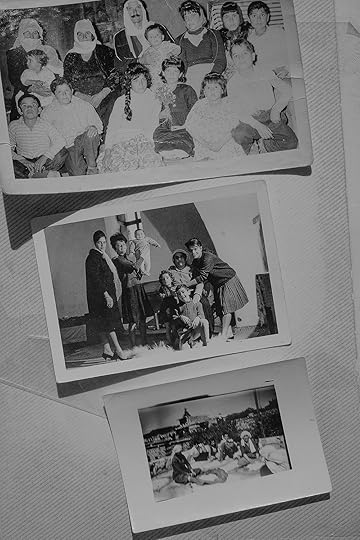 Sara Kontar, Family archive, from the series Paper Home (2024–ongoing)
Sara Kontar, Family archive, from the series Paper Home (2024–ongoing) Assad survived and seemed immoveable. When a coalition of rebel factions suddenly stormed the capital last year, and Assad just as suddenly fled Damascus for Moscow, it was a shock. For the fourteen million Syrians who had been displaced from their homes between 2011 and 2024, half of whom had left the country altogether, it was a shock complicated by laws and statutes that were blind to this dramatic change in circumstances. For the 46,000 Syrians granted asylum in France, returning home would mean voiding their refugee status. That means they are forbidden from going back to Syria, even for a short visit, unless they are willing to leave France forever, or if they are willing to become French citizens first. That is the predicament Kontar is exploring, to powerful and ruminative effect, in the series Paper Home (2024–ongoing), where bureaucratic hurdles stand in the way of real justice and equality.
 Sara Kontar, A family picture captures the essence of unity despite physical distance. Members are scattered across the globe, with some in Germany, France, Saudi Arabia, Syria, and Kurdistan, from the series Paper Home (2024–ongoing)
Sara Kontar, A family picture captures the essence of unity despite physical distance. Members are scattered across the globe, with some in Germany, France, Saudi Arabia, Syria, and Kurdistan, from the series Paper Home (2024–ongoing) 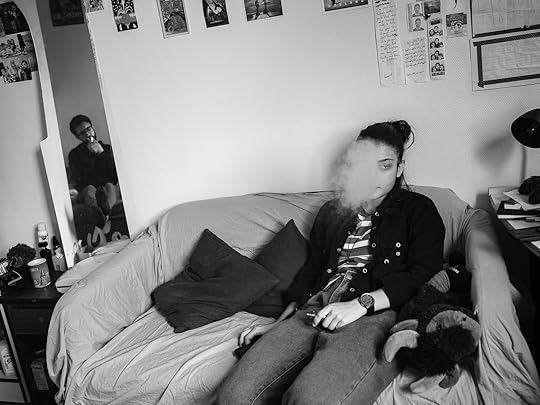 Sara Kontar, Lava and Kais find themselves in the cramped confines of the 14 cubic meters student room, from the series Paper Home (2024–ongoing)
Sara Kontar, Lava and Kais find themselves in the cramped confines of the 14 cubic meters student room, from the series Paper Home (2024–ongoing) Four years after arriving in Paris, Kontar suddenly recovered all the images she had lost. By that point she was experimenting with different materials and modes of image-making. She printed the previously missing images as grainy cyanotypes. For the installation Towards a Light (2022), she arranged them over column of texts and wallpaper replicating an image of the sea. Although the texts tell of a harrowing passage—trying to reach Greece by boat, fighting with smugglers—the images that so troubled Kontar for years appear tender, almost beautiful. “After that, I started documenting the lives of people around me,” Kontar explained. “Everybody’s lost.” People are living in welfare associations, with roommates, far outside their norms. “But when they come together as a group, I love this atmosphere. What I love about documentary is that when you live through these hard stories, the camera becomes a third eye, to look [with] and also to appreciate. It’s another relationship with a space, with exile. All photographers are outsiders. But this is my way out.”
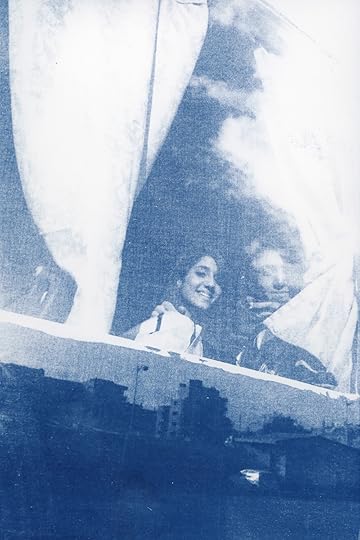 Sara Kontar, Last image of my brother and me, taken by our father in Syria in 2015 on a bus, with the city’s reflection in the window, from the series Towards a Light (2022)
Sara Kontar, Last image of my brother and me, taken by our father in Syria in 2015 on a bus, with the city’s reflection in the window, from the series Towards a Light (2022)All photographs courtesy the artist
 Sara Kontar, An image of my mother embracing my brother upon our arrival in Paris in early 2016, after a two-month journey seeking asylum and crossing multiple borders. My mother had been in France for six months prior, from the series Towards a Light (2022)
Sara Kontar, An image of my mother embracing my brother upon our arrival in Paris in early 2016, after a two-month journey seeking asylum and crossing multiple borders. My mother had been in France for six months prior, from the series Towards a Light (2022) Read more from our series “Introducing,” which highlights exciting new voices in photography.
January 31, 2025
What Is Realism in the Age of AI?
With the advent of generative models that can simulate photography and make images from math, it has become necessary to be more specific in describing images that are not manufactured using such procedures. But what to call them? The term “real photo” was used by several tech news sites in headlines this past summer in reference to Meta’s mislabeling of archival photographs as being “Made with AI.” “Real photo” seems intuitive enough but is misleading if not blatantly oxymoronic. Isn’t every photograph unreal to the extent that it is a representation and not something real, in and of itself? Doesn’t “real photo” remind us of how dubious it has always been to complacently assume that photography objectively documents reality? All the images in question on Meta’s platforms are made of digital code rather than light and chemicals on paper. Does that disqualify them all from realness?
The phrase “real photo” is incoherent. It makes sense not as a description of an image’s ontological status but only as a judgment about image makers, their techniques, and, ultimately, their intentions, as if realness requires the elimination of any particular aim or human point of view. In a sense, the “artificial intelligence” of text-to-image models does precisely that, averaging together billions of indiscriminately ingested images to arrive at statistically based representations of any articulable concept, extracting its “real” essence from empirical contingencies and subjective distortions. Yet evidence of subjectivity is what ordinarily allows us to regard an image as real: as evidence that someone saw something in some particular way and found the means to share that vision. A generative image violates our sense of reality not necessarily because it looks too much or too little like what it depicts but because it tricks us into attributing a point of view to a synthetic depiction.
 AI-generated illustration created by Gregory Eddi Jones, 2024, for Aperture
AI-generated illustration created by Gregory Eddi Jones, 2024, for Aperture  AI-generated illustration created by Gregory Eddi Jones, 2024, for Aperture
AI-generated illustration created by Gregory Eddi Jones, 2024, for Aperture We find an increasing tension in the commonsense notion of a “real photo.” The term is now used to indicate that an image is not machine generated (rather, it is subjective), but it also retains the sense that an image is not faked in more familiar ways, not edited toward some preconceived notion or purpose (it is not subjective). Meta’s recent labeling controversy reflects this confusion in that its reality detector was calibrated to identify any form of digital editing as proof of the adulterating presence of AI, inadvertently stigmatizing retouching processes that have come to be largely accepted as non-falsifying. Conflating any kind of postproduction with automatic generation suggests how “Made with AI” has no clear, stable definition at all. “If ‘retouched’ photos are ‘Made with AI’ then that term effectively has no meaning,” the photographer Noah Kalina posted on Threads. “They might as well auto tag every photograph ‘Not a True Representation of Reality’ if they are serious about protecting people.”
Given its track record of fomenting hate and violence, abetting commercial surveillance and discrimination, and treating users as guinea pigs in undisclosed psychological experiments, it’s hard to believe that Meta is especially serious about protecting people. But even if it were, it’s not clear why such a label would be protective, or why Meta or any other for-profit company with a vested interest in how media is consumed should be regarded as a reliable custodian of reality. It seems safer to take in earnest what Kalina suggests and treat anything posted to social media as effectively falsified by its uncertain provenance and context than to feel authorized to believe everything you see unless Facebook tells you not to. To count on content labels would not only represent a sort of moral hazard with respect to media literacy (“Don’t worry, media platforms will interpret images for you”), it would suggest that the only “safe” images are those that require no interpretation in the first place. This treats users’ interest in images as being strictly a matter of expediently extracting information from them; the best images from this standpoint are verified as “real” in a glance and transfer their data load as efficiently as a hypodermic needle. That way you can consume more, faster.
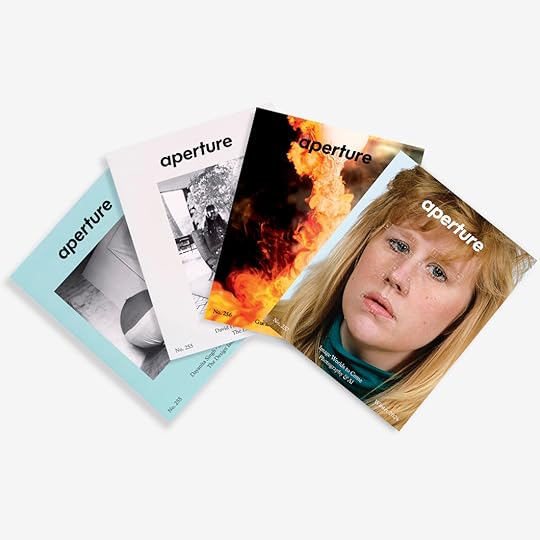 Aperture Magazine Subscription 0.00 Get a full year of Aperture—the essential source for photography since 1952. Subscribe today and save 25% off the cover price.
[image error]
[image error]
Aperture Magazine Subscription 0.00 Get a full year of Aperture—the essential source for photography since 1952. Subscribe today and save 25% off the cover price.
[image error]
[image error] 
In stock
Aperture Magazine Subscription $ 0.00 –1+ View cart DescriptionSubscribe now and get the collectible print edition and the digital edition four times a year, plus unlimited access to Aperture’s online archive.
A tech and media industry group called the Content Authenticity Initiative criticized Meta’s implementation, arguing that only “wholly AI generated” images should be labeled “Made with AI.” But this approach ignores the crux of the problem: the complexities of distinguishing what is “generated” and what is “manipulated” as automated software tools do more to blur the two together. Far from initiating authentic content, the group’s proposition uses the threat of AI to try to bolster the privileged relation to reality of photographic techniques that can’t support it and media outlets that categorically don’t deserve it. Moreover, such labeling figures viewers as bad information processors—who expect images to be dichotomized into true and false but can no longer count on their faulty sensors—and marginalizes the value of ambiguity, irresolution, multivalence, and other aesthetic modes of engaging with images.
“Made with AI” labels presume that, normally, anyone can tell which photographs are “real” simply by looking at them, without any context indicating why the image was made or circulated. This is the implicit theme of a quiz that the New York Times published on its website, in June 2024, headlined “A.I. Is Getting Better Fast. Can You Tell What’s Real Now?” The quiz shows a series of images of celebrities and politicians with a few evocative wild cards mixed in, some of which are machine generated. Echoing the well-rehearsed line of fearmongering about deepfakes, the accompanying copy insists that “fake images can increase the risk that people will be deceived online, and they also risk eroding the public’s trust, making it harder to believe genuine images.” The overall implication is that if you mistakenly believe that a picture of Dwayne “the Rock” Johnson wearing a police uniform in a mall is “real,” that proves how AI has overwhelmed your feeble epistemic capabilities and become a threat to reality as we once knew it.
But if machine-generated images are hard to distinguish from “real” images, it might tell us less about the power of AI models and more about how media contexts have always conditioned our understanding of what we see, patterning “reality” in familiar, formulaic ways. Even if one could spot reality in the surface of an image, as the New York Times’s test implies one should, it would remain a meaningless skill in the abstract and afford no protection, let alone gratification. It’s not as though audiences, even news consumers, only ever want to feast their eyes on facts. Spotting fakes under laboratory conditions says nothing about how well one grasps the “rhetoric of the image” (to borrow a phrase from Roland Barthes) and runs counter to much of the pleasure that looking at images affords.

Spread from Life magazine, 1947
var container = ''; jQuery('#fl-main-content').find('.fl-row').each(function () { if (jQuery(this).find('.gutenberg-full-width-image-container').length) { container = jQuery(this); } }); if (container.length) { const fullWidthImageContainer = jQuery('.gutenberg-full-width-image-container'); const fullWidthImage = jQuery('.gutenberg-full-width-image img'); const watchFullWidthImage = _.throttle(function() { const containerWidth = Math.abs(jQuery(container).css('width').replace('px', '')); const containerPaddingLeft = Math.abs(jQuery(container).css('padding-left').replace('px', '')); const bodyWidth = Math.abs(jQuery('body').css('width').replace('px', '')); const marginLeft = ((bodyWidth - containerWidth) / 2) + containerPaddingLeft; jQuery(fullWidthImageContainer).css('position', 'relative'); jQuery(fullWidthImageContainer).css('marginLeft', -marginLeft + 'px'); jQuery(fullWidthImageContainer).css('width', bodyWidth + 'px'); jQuery(fullWidthImage).css('width', bodyWidth + 'px'); }, 100); jQuery(window).on('load resize', function() { watchFullWidthImage(); }); const observer = new MutationObserver(function(mutationsList, observer) { for(var mutation of mutationsList) { if (mutation.type == 'childList') { watchFullWidthImage();//necessary because images dont load all at once } } }); const observerConfig = { childList: true, subtree: true }; observer.observe(document, observerConfig); }The New York Times quiz is reminiscent of a 1947 Life magazine quiz—mentioned by Fred Ritchin in his 1990 book In Our Own Image: The Coming Revolution in Photography, an early attempt to reckon with digital imaging’s impact on documentation—in which readers were shown a series of headshots and invited to decide which were of criminals and which were of mystery writers. The ostensible point was to disabuse readers of their physiognomic biases. “It was a seductive test, quasi-scientific in its appearance,” Ritchin writes, yet the photographs were “cleverly selected” to trip readers up, playing to and implicitly reinforcing visual stereotypes. By using images of writers with the lighting and camera angles of mug shots, the Life editors hoped to trick readers into drawing conclusions that would make them question their ability to accurately understand the world. As Ritchin puts it, “Life, purportedly challenging stereotypes, primarily managed to show the magazine’s talent in directing the reader.”
To care about which images in the New York Times quiz are faked is not to care about reality as such but about the capability of the newspaper to dictate it, the ability to pass off the photographs it selects for editorial impact as also being reputable presentations of truth. Its images, too, are, in effect, generated, presenting a concept in a heightened, exaggerated, or purified form. The catastrophizing over inane but by and large harmless phenomena such as AI-generated “shrimp Jesus” images on Facebook (which are pretty much what that phrase would lead you to expect) works to recuperate the more established forms of staged imagery in conventional media. It would suit both traditional media’s and social media’s interests if it became customary to assume any image was “inauthentic” unless validated by their imprimatur. Then only someone with press credentials or a platform’s BlueCheck verification could publish a “real photo.”
Deep reals are what happen when documented reality has the grammar of fakeness.
Many machine-generated images are not so different from what Ritchin derides as “editorial photography”: images that “borrow from the photograph’s perceived authority while at the same time manipulating imagery in the service of their own needs.” But generated images borrow not from the authority of photographs’ air of documentary fidelity but from the way we often consume them: spontaneously, as if their immediacy spoke for itself and made it self-evident that an abstract verbal prompt should look like something specific.
Related Stories Interviews Is Documentary Photography at a Crossroads?
Interviews Is Documentary Photography at a Crossroads? Published just as digital photography was beginning to become pervasive, In Our Own Image suggests that the pleasure of consuming photography was still bound up with its automatic visual realism. “Scenes photographed in a straightforward way are presumed to have contained the people and objects depicted,” Ritchin writes. “Unless obviously montaged or otherwise manipulated, the photographic attraction resides in a visceral sense that the image mirrors palpable realities.” Audiences, in his view, were unprepared for a shift to “photographic simulations.” He adds, “Should photography’s relationship to physical existence become suddenly tenuous, its vocabulary would be transformed and its system of representation would have to be reconsidered.”
Advertisement
googletag.cmd.push(function () {
googletag.display('div-gpt-ad-1343857479665-0');
});
That reconsideration is underway. No one now could be ignorant of how photographs are manipulated and montaged; nearly everyone has engaged in such manipulation themselves on their phones. And generative models’ capacity to synthesize and augment images has been widely, relentlessly publicized, with ostensible warnings such as Meta’s “Made with AI” labels adding to the hype. But the reconsideration isn’t one-sided: As people have become more fluent in expressing themselves with images and more familiar with the ubiquity of digital manipulation, they have not correspondingly become more cynical about how images can deceive. They also enjoy what images can be made to say, the concepts they can clarify, the social bonds they can help sustain. Viewers don’t necessarily approach images expecting visual transcripts of reality, but neither have they become fully disillusioned of photography’s promise to preserve a moment. Savviness and disavowal proceed together.
Audiences, of course, still find some “photographic attraction” in realism, but that desire for realism should not be confused with a hunger for evidence. The kinds of images that circulate the widest, especially now, are not the “most real” but those optimized for attention. However, deepfakes don’t call out for deep attention; they want to compress into a superficial glance the desire to look. A deepfake with malicious intent relies on the same logic as content labeling: that viewers approach images as if they are absolutely true or false and decide instantly which is the case. It expects to be seen as true at a glance, injecting its false information into the hapless, duped viewer. Generative images that hurry viewers from idea to already-rendered output, and editorial photography with its reinforced stereotypes, work similarly, aiming at a realism that confirms biases, passing them off as what everyone else already thinks.
 AI-generated illustration created by Gregory Eddi Jones, 2024, for Aperture
AI-generated illustration created by Gregory Eddi Jones, 2024, for Aperture  AI-generated illustration created by Gregory Eddi Jones, 2024, for Aperture
AI-generated illustration created by Gregory Eddi Jones, 2024, for Aperture What is experienced as real—what seems “authentic”—derives from persuasive details, not accurate ones. Realism is not a mode of documentation, a degree of fidelity, but a set of conventions that coalesce around an affective appeal, a kind of nostalgia for a shared ground truth, “what everyone believes,” rather than an irrefutable depiction of it. A deepfake plays to the idea that what can be made viral will seem more and more real until it achieves a kind of Swift boat–esque certitude from being repeated and reported so often. The image’s notoriety becomes its main context, if not the “real” thing that’s captured, overriding what is represented in the image. The notion of “realism” becomes a participatory mode of consumption. The reality inheres in the circulation and not the event.
But as our relation to realism is affective, it is not resolved through assigning pass/fail grades to images on a reality test. Images that suspend us between the two, or between different interpretations, can be more compelling, more participatory, and go as viral (as the arguments over what color “the dress” was in 2015 demonstrated). Enjoying “realism” is not just seizing a moment of validation and authentication, it is also being suspended between the real and the possible.
One might call such images “deep reals,” a phrase that the social theorist Nathan Jurgenson used to describe videos taken during a recent tornado outbreak in Nebraska. For many people, the twisters in these clips seemed too realistic to be real—too much like what an image generator would produce. The instantly iconic image of Donald Trump after the attempt to assassinate him is another example. Deep reals are what happen when documented reality has the grammar of fakeness, of computer-generated image simulation. It is a kind of realness that depends on and plays off the ubiquity of generated images and generalized anxiety about deepfakes. They correspond to expedited visual consumption too well; they are “real” images that foreground special effects that haven’t actually been used.
Such images don’t make the preconceived and often deeply desired notions about the world disappear into a taken-for-granted visuality; they instead insist on an image’s formal qualities as being in a kind of tension with its content through their very suitability or obviousness. Rather than trying to repress our skepticism, as a deepfake would, a deep real elicits that skepticism at a deeper level, with the picture’s immediate potency undermining rather than confirming its veracity. When a deepfake presents an idea, it deliberately conceals the use of techniques of manipulation and persuasion, trying to thereby appear as a “real photo.” Whereas when a deep real gives us a ready-made concept, it foregrounds what should be taken as manipulative, challenging us to see it anew.
This article originally appeared in Aperture No. 257, “Image Worlds to Come: Photography & AI.”
Steven Cuffie’s Tender Portraits of Black Life in Baltimore
A photograph is the perfect medium for projecting one’s ideas, assumptions, opinions, and beliefs onto a stranger, especially when there’s little to no information provided about the person in the image. Such projection offers fertile ground for every manner of bias and discrimination, of course, yet there is something thrilling about building narratives around pictures of strangers, something romantic about imagining the intricacies of their lives, their interests, their fates. While a great deal of mystery surrounds nearly all of Steven Cuffie’s subjects, in the instance of a recent posthumously published book, Karen 1979 (2024), we at least get a name.
 Steven Cuffie, Untitled (Boys on Jungle Gym), 1976
Steven Cuffie, Untitled (Boys on Jungle Gym), 1976Who is Karen? Perhaps we should back up: Who is Steven Cuffie? As with his subjects, the facts are spare. He was born in North Carolina, in 1949, but grew up in Baltimore. For more than two decades, Cuffie was employed as a photographer for the city, recording the mundane events of civic life, from mayoral speeches to street repairs. Marcus Cuffie, the photographer’s youngest child, remembers a quiet man most happy in the darkroom. “I don’t think there was an event I experienced as a child that went undocumented by him,” Marcus recalls.
Cuffie appreciated his day job, which allowed him to hone his craft, but yearned to make photographs that would put him in conversation with the names on his bookshelves, names such as Walker Evans, Dorothea Lange, and Gordon Parks. Yet aside from a few group shows in the 1970s, he never exhibited his images, which for decades languished in boxes discovered by Marcus and their siblings only after their father died, in 2014. He had never discussed this early work, made when he was a bachelor, with his children.
 Steven Cuffie, Untitled (Young Girl on Stoop), ca. 1970s
Steven Cuffie, Untitled (Young Girl on Stoop), ca. 1970sMarcus has recently started the process of organizing their father’s extensive archive. Along with the photographer Ethan James Green, they’ve curated their findings in elegant presentations at Green’s New York Life Gallery on the Lower East Side of Manhattan. The gallery’s inaugural exhibition, Women, in 2022, offered a broad survey of Cuffie’s black-and-white photography. It was accompanied by a zine of the same name and followed up with the first full book of Cuffie’s photography, Baltimore Portraits (2023), which brings together two bodies of work made between 1976 and 1985—gritty, tender street portraits of Black life in Baltimore and portraits of women. These are unadorned, sultry, playful, glamorous, unillusioned, bare-breasted, and confrontational women —seen both in and out of the boudoir. The second book, Karen 1979, identifies one of these sitters, bringing her front and center.
A great deal of mystery surrounds nearly all of Steven Cuffie’s subjects.
I wonder how Karen met Cuffie. Was it in the seductive glow of candlelight at a local nightclub, him admiring her across the bar, her coyly smiling and looking away? Was jazz playing, “Alone Together” by Kenny Dorham, or maybe “Love Song from ‘Apache’” by the Coleman Hawkins Quartet? Were they neighbors? Did he pass by her sitting on her stoop in East Baltimore on his way home from work each day, her eyes searching the pages of a book and his eyes searching her? Is Karen still with us? Has she heard about this book and the show in New York? Would seeing her younger self on full display, for a world of strangers to witness, affirm her youthful beauty, or would it make her angry, scornful even?
 Steven Cuffie, Untitled (Karen), 1979
Steven Cuffie, Untitled (Karen), 1979All photographs courtesy Steven Cuffie Archive
Karen’s rich dark skin, dewy shoulders, elegant round nose, and penetrating eyes are at once disarming and alluring. She strikes me as a woman of great confidence, perhaps barely bolstered by Cuffie’s pursuit. Even in dishabille, Karen is always well-dressed, tailored to perfection in chic dresses and festooned with delicate necklaces, earrings, and bracelets. Her hair is ever changing: Hot-combed, side-parted updos with thick spirals on the sides. Sheeny mushrooms with whispers of runaway hair as she sprawls on the austere bed or gazes dreamily from the couch. Sleek roller-set coils, moving precisely into a loose bun or a French roll. Such attention to detail reveals a woman deeply concerned with her image but at home in her beauty.
Related Items

Aperture Magazine Subscription
Shop Now[image error]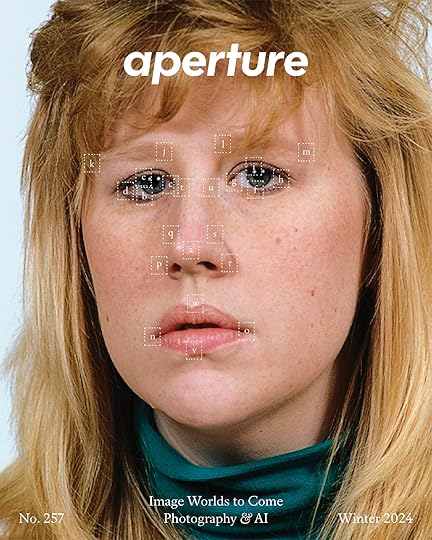
Aperture No. 257
Shop Now[image error]Seeing a Black woman through the lens of eros is nothing new. Photographers such as Chester Higgins Jr., Tony Currin, Jules Allen, and Howard Morehead all made bodies of work extolling the beauty of Black women. And in the broader photographic landscape, there’s plenty of correspondence between Cuffie’s style and that of his non-Black peers: Robert Mapplethorpe and his obsession with discovering the perfect Black male penis. Karlheinz Weinberger and his male pin-ups. George Dureau and his fetishizing pictures of disabled and impoverished folks. And Nobuyoshi Araki and his sometimes painful photographs of women in bondage. Steven Cuffie belongs to their complicated canon, one of frequent power imbalances and possible exploitation.
What I love most about these photographs is what repeatedly breaks my heart. How familiar Karen feels to me. How much like my mother she looks, or my grandmother, or my great aunt Carolyn. Looking at these pictures and thinking of these women—strong women who are the very baseline for my understanding of love, care, and beauty—I feel almost desperate to know Karen and how the rest of her life played out. At the very least, I’m grateful we get to see her, a stand-in for so many unknown, unnamed Black women, forever young in the image, playfully oscillating between shy and serious poses. And thankfully, we know her name.
This article originally appeared in Aperture No. 257, “Image Worlds to Come: Photography & AI,” under the column Redux.
January 24, 2025
David Lynch’s Outsized Influence on Photography
The director David Lynch, who died this month at seventy-eight, blended a dark surrealism with banal Americana to create hypnotic, dreamlike atmospheres. His plots were cryptic; his characters eccentric and unforgettable; his love of coffee, cherry pie, and Transcendental Meditation, legendary. Lynch was an artist of total originality who invented his own cinema of the unconscious, influencing generations of image-makers. Here, a group of photographers pay homage to the beloved filmmaker.
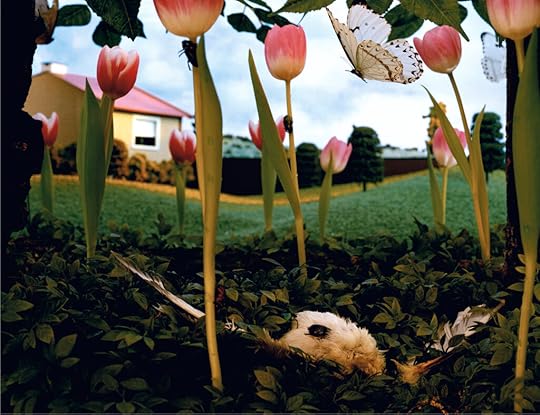 Gregory Crewdson, Untitled, 1991-1997
Gregory Crewdson, Untitled, 1991-1997© the artist
Gregory Crewdson
I had just begun graduate school at Yale in 1986 when Blue Velvet was released. I went on opening night to the York Square Cinema, and the film changed my life. I immediately connected to Lynch’s take on the American landscape, its veneer of domestic order, and his exploration into its darker undercurrents. These were themes I had already been exploring myself, but Lynch conveyed them in such a shocking and visually beautiful way, with such immediacy and confidence. Blue Velvet seemed new and yet strangely familiar—the very definition of the uncanny—like a dream I could only partially remember or understand. As with all great art, it left me with more questions than answers, and it compelled me to turn back to my own work and dig deeper within myself. A series of photographs, Natural Wonder (1991–97), almost entirely grew out of my obsession with the opening sequence of Blue Velvet. I constructed tabletop dioramas of neighborhoods with picket fences, garden flowers, taxidermies of birds and insects, and human body parts morphing with nature in grotesque and bizarre ways. I took nearly a decade to work through this exhaustive artistic exercise, having absorbed Lynch’s influence and needing to express it in my own way. I was then able to move on to other concerns in my work, but I would not have gotten there in the same way without Lynch—which is how art and inspiration works. Lynch’s legacy is even more vast than his body of work, for it touched so many other artists, influenced the stories we tell, and informed the way we see the world.
 Roe Ethridge, Anna Weyant in Amagansett, 2023
Roe Ethridge, Anna Weyant in Amagansett, 2023Courtesy the artist and Andrew Kreps Gallery, New York
Roe Ethridge
The way I remember it, Scott Vogel’s video class at Atlanta College of Art was the day after a Twin Peaks episode aired on television. Scott would tape it, and we would then watch it as students after having already watched it as rabid fans the night before. The lesson I think Scott was interested in, what he wanted us to grasp, was the way the show somehow passed through the narrows of prime time. We “deconstructed” every episode, though I’m not sure that’s what we were doing. Really it was more like marveling at the skill, the show’s beauty and terror, both sublime and banal. I think what I saw was how a real artist could use the most ubiquitous venue to make the most shocking and radical images and stories. In a way, it was the most American thing ever: Twin Peaks was prime time.
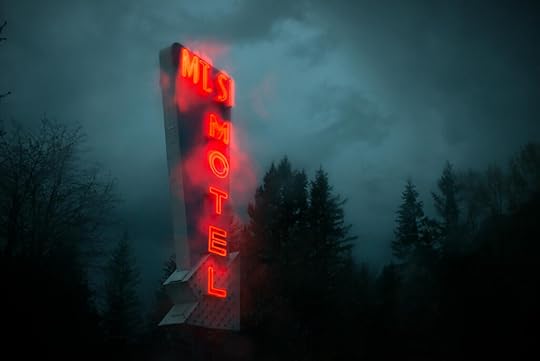 Todd Hido, Outside the Mt. Si Motel in North Bend, 2017, for Time
Todd Hido, Outside the Mt. Si Motel in North Bend, 2017, for TimeCourtesy the artist
Todd Hido
In 2017, Paul Moakley from Time magazine offered me what is still one of my favorite editorial assignments ever. A new limited series of Twin Peaks was about to air, twenty-five years after its first season, in 1990, changed television storytelling forever. Paul recognized the kinship between David Lynch’s work and mine, the way that we were both concerned with the darker, more uneasy side of American suburban life, and he sent me to northern Washington to shoot a photo-essay inspired by the locations of the original series.
As a native of Kent, Ohio, who had moved to Oakland, California, I had already spent the last fifteen years going up to Washington state, since it served as a visual surrogate for the dark winters of my childhood landscapes. For this photo-essay, I established a working area within a two-hour radius of Snoqualmie and set out to photograph anything that left an impression on me, looking for things that felt as if they had the essence of Lynch’s darkness. Like many great narratives, the final setting was the sum of many parts and places. I made this picture of Mount Si Motel one rainy evening in North Bend, Washington.
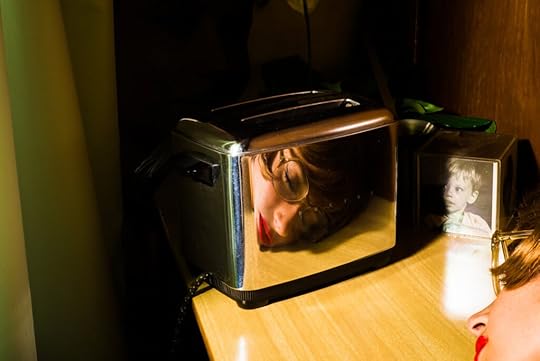 Tania Franco Klein, Toaster (self-portrait), 2016
Tania Franco Klein, Toaster (self-portrait), 2016Courtesy the artist
Tania Franco Klein
The Lynchian universe is captivating, to say the least, with its intense, colorful, and atmospheric surfaces. Once they catch you, they invite you to experience a dark underbelly full of uncanny symbolism, which is surprisingly constructed with the most ordinary elements.
On a less visual and a more psychological and subtle level, the absurdist and abstract narratives of his films, created with mundane elements, were always more fascinating to me. Surrealism is a term often thought of when describing his masterful work, but the absurdism and broken narratives, full of dark holes and ambiguity, always felt more assimilated to the way I experience life and felt more accurate than a perfectly wrapped storyline in which everything is overexplained. Strange events never felt more seductive and complex than in his universe, and I found it hard to resist incorporating many of these fascinating elements into my practice.
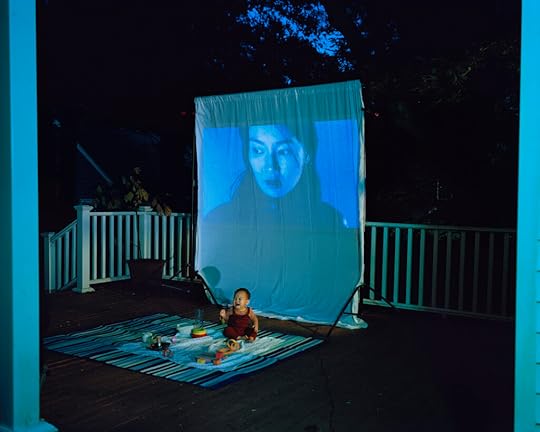 Jarod Lew, Maggie and Baby J, 2024
Jarod Lew, Maggie and Baby J, 2024Courtesy the artist
Jarod Lew
I remember watching Blue Velvet for the first time and being captivated by the absurdity of certain scenes in that film. In the dark basement of a suburban home, I sat around with friends as the glow of an early ’90s television filled the room, and the song “Blue Velvet” filled all our ears. I remember asking myself many times, How does one come up with an idea like that? Why does this feel so real? It wasn’t until later in my life that I watched the documentary David Lynch: The Art Life and realized that the scenes I was most perplexed by, truly haunted by, were scenes that came from his experience as a child. His memories had infused his works so seamlessly. It’s powerful to think that our most visionary endeavors can emerge from simply remembering our past.
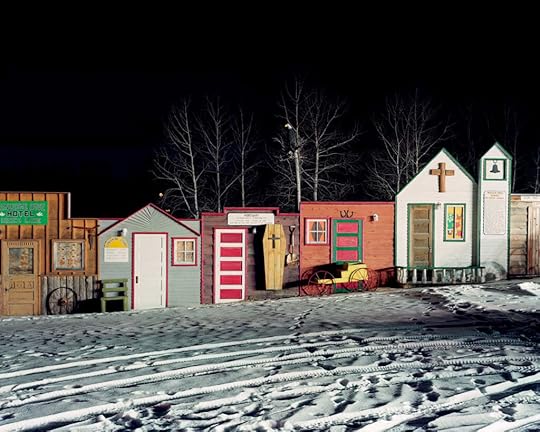 Alec Soth, Minnesota, 2007
Alec Soth, Minnesota, 2007Courtesy the artist
Alec Soth
I discovered David Lynch as a teenager—the same time I discovered art. Living in exurban Minnesota, I found it miraculous that someone could unearth so much mystery in places like North Carolina (Blue Velvet) and Washington state (Twin Peaks). After visiting his dream worlds, every middle-American street looked like a portal to somewhere dark and magical.
 Yelena Yemchuk, Still from Mabel, Betty & Bette, 2019
Yelena Yemchuk, Still from Mabel, Betty & Bette, 2019Courtesy the artist
Yelena Yemchuk
Once in a blue moon we are blessed with a visionary artist who can transform our reality. An artist who can pick us up and drop us in an unfamiliar world—a world that feels simultaneously immediate and elusive. A world with so much light and darkness. A world where dreams rule, and time has no rules.
David Lynch, you know what it feels like to be there—in the place beyond description. You have been taking me there since I was fifteen. When I saw Blue Velvet, I came out of the theater a different me. Thank you for being my biggest inspiration and for teaching me to follow my absolute vision and to not be afraid of telling a different story, one that people might not understand. Thank you for inspiring me to work from my dreams and allow chance and accident to coexist with the “plan.” I learned to keep my eyes wide open for mysteries to reveal themselves without ever having to explain them. You are forever the greatest, David Lynch.
Related Items
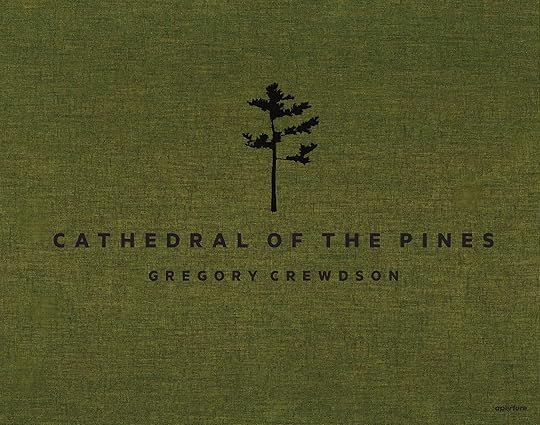
Gregory Crewdson: Cathedral of the Pines
Shop Now[image error]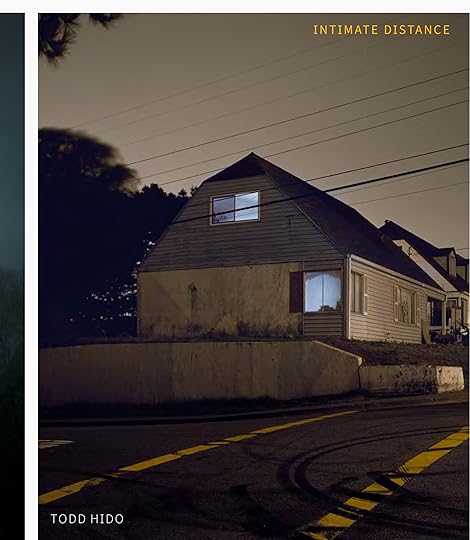
Todd Hido: Intimate Distance (Revised and Expanded Edition)
Shop Now[image error]How Awol Erizku Is Building a Visual Multiverse
Awol Erizku’s vision is as expansive as it is restless. His work across photography, film, sculpture, and installation reimagines African American and African visual culture, from hip-hop vernacular to Nefertiti, while nodding to traditions of spirituality and Surrealism along the way. Aperture has worked with Erizku for close to a decade. In 2016, his striking portrait of a young woman at an Afropunk festival, pictured against a luminous orange backdrop, graced the cover of Aperture’s “Vision & Justice” issue. In 2023, Aperture published Mystic Parallax, a book blending Erizku’s studio practice with his work as an in-demand editorial photographer, including his conceptual portraits of cultural icons such as Solange, Amanda Gorman, and Michael B. Jordan. “It’s important for me to create confident, powerful, downright regal images of Black people,” Erizku has said of his distinctive approach to portraiture. For Mystic Parallax, the curator Antwaun Sargent interviewed Erizku about the motifs that cycle through his art, remixing the Western canon, and his fluid approach to media.
 Awol Erizku, Heads #2 (detail), 2013
Awol Erizku, Heads #2 (detail), 2013  Awol Erizku, Ruth E. Carter’s costume design, featuring a pair of Nike Air Revolutions like the ones worn by Radio Raheem in Do the Right Thing; purses and starburst earrings for Coretta Scott King, in Selma; and Tina Turner’s pumps, from What’s Love Got to Do with It. New Yorker, 2018
Awol Erizku, Ruth E. Carter’s costume design, featuring a pair of Nike Air Revolutions like the ones worn by Radio Raheem in Do the Right Thing; purses and starburst earrings for Coretta Scott King, in Selma; and Tina Turner’s pumps, from What’s Love Got to Do with It. New Yorker, 2018 Antwaun Sargent: This book presents you as an image maker, and not necessarily in one particular box. The sculpture, the painting, the photography, the installation. When I first met you, though, all those years ago, the label that folks were associating with you was “photographer.” What first motivated you to make images in this world?
Awol Erizku: I guess you could say it was a meandering path getting to photography. If we go back to high school, I was doing medical illustration, which is very technical. Senior year, I began making figurative paintings. Sophomore to junior year of college is when I really started making serious, conceptual photographs.
Even though I didn’t have the lexicon to discuss or define what a picture such as Girl with a Bamboo Earring (2009) meant for me at that time, I was thinking about it conceptually. When I considered the Old Masters, I thought: What’s the most direct visual format I can employ to make something that can subvert the Western canon?
Of course, at the time, and this is still true, the most pressing question for me was Black representation. This image became a way of talking about Blackness and dimensions of Blackness without focusing on my subjects in their own environments and the conditions of where they came from. Instead, it’s about their style, aesthetic, and the celebration of their uniqueness.
Access to social media platforms such as Tumblr then enabled a kind of leveling. Where it once took many years to be exposed to a work of art by way of exhibitions and printed matter, now the same number of people, if not more, could see a new work of art in a fraction of the time and share it worldwide. For me, the conceptual aspect of that has always been the Google search suggestion for when someone looks up Vermeer’s Girl with a . . . and stumbles upon Girl with a Bamboo Earring.
 Awol Erizku, Girl with a Bamboo Earring, 2009
Awol Erizku, Girl with a Bamboo Earring, 2009  Awol Erizku, Boy with the Red Turban, 2014
Awol Erizku, Boy with the Red Turban, 2014 Sargent: That image is part of a larger body of work, of friends, family members, and strangers, that you recast using art-historical references. The subject in Girl with a Bamboo Earring is, famously, your sister. Can you talk about that body of work in relationship to, at that point in your career, how you were reconsidering the art-historical with the camera?
Erizku: In a lot of ways, this work was very much a reaction to the kind of conditioning and schooling that I was getting at the time. I was using that image as a way to propose a new ideal and to combat the popular visual culture that seldom celebrated the type of subjects I was drawn to from the streets and the neighborhoods I spent most of my time in. It’s about being indoctrinated and being told a specific version of history and art. Then having to accept the fact that you don’t really see yourself in that, and yet you have to memorize and recite these names, places, and ideologies.
I remember watching the film Girl with a Pearl Earring in a class in high school and thinking, This has nothing to do with the things that I see every day. I literally would leave the projects to go to school, and on my way, I might get stopped by somebody trying to rob me.
Sargent: You went to an art high school, right?
Erizku: Yes. I come from this really harsh neighborhood in the South Bronx, and then I’d go to Manhattan. Your experience is one reality, and then you’re told, This is how the world is. Let’s not forget, this is pre–social media.
Sargent: And before a racial reckoning in the art world, or even caring about Black people.
Erizku: Exactly. I was using the camera, or just art in general, as a way to ask: Is this really the only way we can see the world, or can beauty be seen in other things? For me, the reason why Girl with a Bamboo Earring is poignant is that, regardless of the subject being my sister, I think it’s about an undeniable beauty that isn’t Eurocentric.
 Awol Erizku, RBG Tychism, 2021
Awol Erizku, RBG Tychism, 2021  Awol Erizku, Ruth E. Carter’s costume design, from Malcolm X, two embroidered kufis for Elijah Muhammad, Malcolm X’s sometime mentor, and one kufi for an assistant of Muhammad’s. New Yorker, 2018
Awol Erizku, Ruth E. Carter’s costume design, from Malcolm X, two embroidered kufis for Elijah Muhammad, Malcolm X’s sometime mentor, and one kufi for an assistant of Muhammad’s. New Yorker, 2018 Sargent: We’re in this moment in photography where the conceptual and the commercial are often blended. But from the very beginning of your practice, you’ve always sought to do that, by showing images in different contexts, whether in a museum or a magazine, or, when starting out, on Tumblr.
Erizku: I always consider what my images can be. Sometimes sculptures end up becoming images when they are photographed. Or sometimes images are presented as sculptures. For me, and you know this very well, the studio is my universe. Whatever makes it into my studio enters the ongoing dialogue within my universe.
In the case of the traditional photographs, I’ve always considered them photographs of us. When I say “us,” I mean the diaspora. Melanated people around the world. One of the things that I learned to do early on was understand my position in whatever space—art space, commercial space—and try to make the best work from that position. If I pick up a camera to photograph anybody, anything, it has to start with the purest intention. It has to be done so that, ultimately, it is another offering into a continuum, into the constellation of vast imagery of who we are. It’s never just about my preoccupation with art history. It has so much to do with what I want to see evolve in our culture. I think that kind of thinking also leads me back to music, which, again, coming from the Bronx, you have to respect hip hop. When I started making associations and images that were inspired by lyrics or subcultures, they came from a place of honoring and understanding the true essence of it all, and making a solid effort to elevate it.
I always think about my work as a constellation, and a new piece is just another star within the universe.
Sargent: You have this association with music from jazz to hip hop, which is an enduring association with Black sonic progression in the culture—
Erizku: Improvisation.
Sargent: Exactly. You have Nipsey Hussle, DMX, Jesse Boykins III, and Beyoncé as these different icons in your work. But then there’s also your use of color, the use of gold and how that is very hip hop. But it’s also something very distinct in the parts of African culture that you engage with in your practice. It’s not just the people who are photographed, but the way you’re using color to think about links between Black cultures.
Erizku: Absolutely. Color plays many roles. Purple is commonly known as a regal color. I try to depict my subjects as highly dignified versions of themselves. I ask them to project their idealized selves. Whenever I make a portrait of someone, I make a point to let that person know they should think of themselves as highly as they possibly can. I often say, “We are here because we’re making this image of you, and we want this moment to last.” If I’m making an image of someone, whether they are a celebrity or not, it’s almost always a collaboration. I think I leave enough room for that person to bring their own idiosyncrasies into the image.
Sargent: Why is it important that it’s a collaborative image?
Erizku: I know this may sound cheesy, but when you take someone’s photo, you’re really capturing their soul. It’s not something that I go into every session thinking about, but when I find myself there, when I’m locked in with any subject, there’s an immaculate synergy that flows. I can only tease out those moments through collaboration. It can never happen with me just directing poses.

Awol Erizku, Malcolm X Freestyle (Pharaoh’s Dance), 2019–20
var container = ''; jQuery('#fl-main-content').find('.fl-row').each(function () { if (jQuery(this).find('.gutenberg-full-width-image-container').length) { container = jQuery(this); } }); if (container.length) { const fullWidthImageContainer = jQuery('.gutenberg-full-width-image-container'); const fullWidthImage = jQuery('.gutenberg-full-width-image img'); const watchFullWidthImage = _.throttle(function() { const containerWidth = Math.abs(jQuery(container).css('width').replace('px', '')); const containerPaddingLeft = Math.abs(jQuery(container).css('padding-left').replace('px', '')); const bodyWidth = Math.abs(jQuery('body').css('width').replace('px', '')); const marginLeft = ((bodyWidth - containerWidth) / 2) + containerPaddingLeft; jQuery(fullWidthImageContainer).css('position', 'relative'); jQuery(fullWidthImageContainer).css('marginLeft', -marginLeft + 'px'); jQuery(fullWidthImageContainer).css('width', bodyWidth + 'px'); jQuery(fullWidthImage).css('width', bodyWidth + 'px'); }, 100); jQuery(window).on('load resize', function() { watchFullWidthImage(); }); const observer = new MutationObserver(function(mutationsList, observer) { for(var mutation of mutationsList) { if (mutation.type == 'childList') { watchFullWidthImage();//necessary because images dont load all at once } } }); const observerConfig = { childList: true, subtree: true }; observer.observe(document, observerConfig); }Sargent: Along with the portraits, you also make many still lifes. What led you to that genre?
Erizku: A lot of it is just being in LA. The change of scene from New York, from leaving the hustle and bustle and settling into a vast city that I didn’t know too well. LA is not the easiest place to meet people organically. I focused more on painting and sculpture when I arrived. The objects I collected for sculptures became subjects for my light tests. That turned into an aesthetic investigation of things, whether photographing a rock on wheels or different kinds of flowers and plants under different lights.
Sargent: Within those still lifes, two dominant motifs are the African mask and the Nefertiti bust. You place these objects in relationship to flowers or various other objects, including guns, records, and books. There are endless juxtapositions. Those two symbols also travel throughout your practice, from photography to sculpture to installation.
Erizku: The African mask has this really rich, complicated, troubled history, particularly in the Americas and Europe. Man Ray, Picasso, and Modigliani used African masks. These are not people who come from the places where those masks are from. To my knowledge, they don’t have blood affinity to these places.
I started working with African masks during my first year at Yale and continued to work with them for several years before I hit a spiritual firewall. As a practitioner of the Muslim faith, I could not uphold or invest any spiritual value in objects made for commercial consumption (I bought them on the street in New York).
This was a blessing in disguise. It allowed me freedom to make the only move that I felt was missing in the African mask dialogue, which was burning them as a way to make something I had never seen before. For me, that was a very symbolic moment, both personally and politically. A premonition of where I felt the world was headed. These works were made from the end of 2018 through the pandemic in 2020. It was a tumultuous time. Trump was in office. I was on the verge of becoming a father for the first time. The world was equally exciting and extremely terrifying.
Also around the same time, there was a surge of artists using African masks. Whether in sculpture or photography, artists were making mediocre mask-related works. What was missing in all of this noise? For me, it was how people dealt with African masks in a post-spiritual aspect.
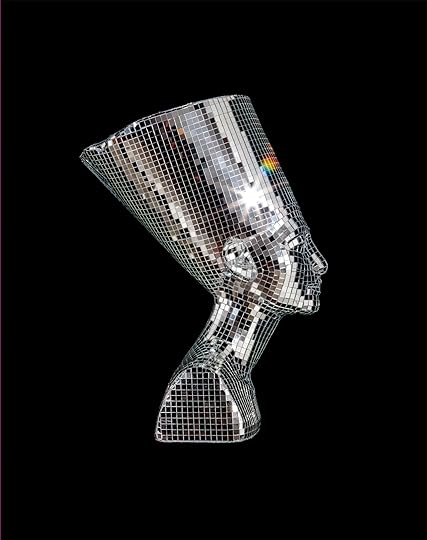 Awol Erizku: Mystic Parallax 52.50 Mystic Parallax is the first major monograph by rising interdisciplinary artist Awol Erizku.
Awol Erizku: Mystic Parallax 52.50 Mystic Parallax is the first major monograph by rising interdisciplinary artist Awol Erizku.$75.00 $52.5011Add to cart
[image error] [image error]
In stock
Awol Erizku: Mystic ParallaxArtworks by Awol Erizku. Foreword by Ishmael Reed. Essays by Ashley James and Doreen St. Félix. Conversations with Urs Fischer and Antwaun Sargent.
$ 52.50 –1+$75.00 $52.5011Add to cart
View cart Description Mystic Parallax is the first major monograph by rising interdisciplinary artist Awol Erizku.Working across photography, film, video, painting, and installation, his work references and re-imagines African American and African visual culture, from hip hop vernacular to Nefertiti, while nodding to traditions of spirituality and Surrealism. This comprehensive monograph spans Erizku’s career, blending his studio practice with his work as an in-demand editorial photographer working regularly for the New Yorker, New York magazine, Time, and GQ, among others, and features his conceptual portraits of Black cultural icons, such as Solange, Amanda Gorman, and Michael B. Jordan. As Erizku recently told the New York Times, “It’s important for me to create confident, powerful, downright regal images of Black people.”
Featuring essays by critically acclaimed author Ishmael Reed, curator Ashley James, and writer Doreen St. Félix, and interviews with the artist by Urs Fischer and Antwaun Sargent, Mystic Parallax is a luminous and arresting testament to the artist’s tremendous power and originality.
Copublished by Aperture and The Momentary Details
Format: Hardback
Number of pages: 300
Number of images: 168
Publication date: 2023-07-11
Measurements: 9.5 x 12 x 1.5 inches
ISBN: 9781597115469
“The book features 300 pages of Erizku’s visual works, which reference and reimagine Black contemporary culture while nodding to elements of nature and spirituality—creating a canonized version of history he calls ‘Afro-Esotericism.’”—Maxine Wally, W magazine
“And its contents are even more potent than its eye-catching exterior.”—Caroline Bomback, Cultured magazine
“Erizku’s work simultaneously subverts and transcends the voracious strictures of Western cultural hegemony without losing a step.”—Miss Rosen, Blind magazine
ContributorsAwol Erizku (born in Ethiopia, 1988) lives and works in Los Angeles. He graduated from Cooper Union in 2010 and received his MFA from the Yale School of Art in 2014. Erizku has exhibited at the Museum of Modern Art, New York; Crystal Bridges Museum, Bentonville, Arkansas; Museum of Contemporary Art Toronto; Ben Brown Gallery, Hong Kong; Night Gallery, Los Angeles; Gagosian, New York; and FLAG Art Foundation, New York.
Ishmael Reed is a critically acclaimed author, poet, and playwright known for his satirical and ironic take on race and literary tradition. He is the recipient of numerous awards and honors, including fellowships from the MacArthur Foundation, the Guggenheim Foundation, and the National Endowment for the Arts.
Ashley James is an associate curator of contemporary art at the Solomon R. Guggenheim Museum in New York, where her work merges curatorial practice with an academic background rooted in African American studies, English literature, and women’s, gender, and sexuality studies.
Doreen St. Félix is a staff writer at the New Yorker and has previously written for publications, including the New York Times, Vogue, n+1, and Pitchfork.
Urs Fischer is a Swiss-born artist who works across sculpture, installation, and photography.
Antwaun Sargent is a writer, curator, and a director at Gagosian Gallery. His recent books are The New Black Vanguard: Photography Between Art and Fashion (Aperture, 2019) and Young, Gifted and Black: A New Generation of Artists (2020). His recent curatorial projects include a series of group shows called Social Works, as well as solo presentations of artists Virgil Abloh, Awol Erizku, Rick Lowe, Tyler Mitchell, Alexandria Smith, and Amanda Williams.
 Aperture News A Look Inside the Book Launch for Awol Erizku’s Long-Awaited First Monograph
Aperture News A Look Inside the Book Launch for Awol Erizku’s Long-Awaited First Monograph 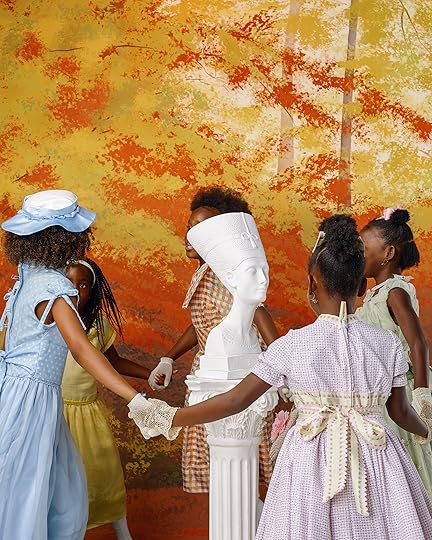 Portfolios Awol Erizku’s Surreal Visions of Africa and Its Diaspora
Portfolios Awol Erizku’s Surreal Visions of Africa and Its Diaspora  Portfolios Vision & Justice: Awol Erizku
Portfolios Vision & Justice: Awol Erizku Sargent: With Nefertiti, you use this symbol in numerous ways: as a white bust painted black, within still lifes, as a light box, as a disco ball, fabricated in both silver and gold. How did you come to Nefertiti?
Erizku: It has to do with the notion of reclamation. I grew up being reminded of what and who I looked like as a young boy. I would often hear that I reminded people of someone who is Egyptian or Ethiopian or Eritrean, even Cuban at times (only in the Bronx). These little side comments, often meant to be offensive, stuck with me. As an adult, I realized identity itself is a kind of conceptual material to make work from. My identity shifted as I found myself in different parts of the world. When I began growing my locs, eight or nine years ago, that also complicated things. People used my features to categorize who I am and where they thought I was from.
To come back to Nefertiti, I felt she had an aura that I gravitated toward. Yes, she’s an Egyptian figure, but what does that actually mean today? The original bust of her resides in a Berlin museum. Hollywood movies often depict Egyptians from ancient times with Eurocentric features and mannerisms. I find the whitewashing of African sovereign states and their representations troubling. I want people to think of her and other important Black African figures as Black first, before anything else. Her image across the diaspora is supreme. For me, it’s a direct way of signaling Black influence, a quick way of anchoring our collective efforts and countering the continued whitewashing of her identity.
 Awol Erizku, Installation view of Memories of a Lost Sphinx, Gagosian, New York, 2022
. Photograph by Rob McKeever
Awol Erizku, Installation view of Memories of a Lost Sphinx, Gagosian, New York, 2022
. Photograph by Rob McKeeverCourtesy Gagosian
Sargent: The Nefertiti disco ball in the Memories of a Lost Sphinx exhibition that we did in 2022 spun and reflected light; it was almost like a cosmic presence. It became a universe. It became a portal. You’ve talked a lot about the use of surrealist notions to create your own universe.
Erizku: I find a lot more surrealism in real life than in what the imagination could conjure. Life is very strange, and I take a lot of cues from personal, day-to-day shit. I try to reflect and mirror what I see in the world around me.
Sargent: There’s also a Pan-African element to your work, with the use of the tricolor flag.
Erizku: Nefertiti and the Pan-African flag are kind of interchangeable to me. They offer a way for us to see ourselves in imagery, in sculpture, in fashion, and universally in a work of art. When you see Black art in non-Black spaces, it radically changes the dynamic in the space. I remember visiting so many European museums and not seeing any Black art and feeling left out, thinking that they’re missing out on a great deal of history. So, my inclination and my practice is to make things that not only evoke a certain kind of feeling but unapologetically dominate the spaces they occupy.
Sargent: How do you think about location in your image making?
Erizku: When I’m on location, I’m very specific about incorporating the surrounding environment as much as possible. I think, again, it goes back to the idea of creating a universe. Black beings in an environment, being themselves, being cool, calm, and collected. They’re dignified; they’re exercising a high form of regality; they are seldom timid. They’re owning the space.
 Awol Erizku, Amanda Gorman, TIME, 2021
Awol Erizku, Amanda Gorman, TIME, 2021  Awol Erizku, Tessa Thompson, New York, 2018
Awol Erizku, Tessa Thompson, New York, 2018 Sargent: There’s also something about nature—you often bring the natural world into the studio. We see Black figures interacting with nature, showing a command of nature, as with Tessa Thompson and the falcon, or Amanda Gorman and the caged bird.
Erizku: I mean, you said it. For me, it’s important that we show these figures in command. It is a literal and a metaphorical gesture. Kids like myself grew up looking at newsstands and collecting magazines, which informed our understanding of the world. Life imitates art. I think of my younger self running around bookshops and grabbing any new magazine that had the most exciting cover on it, just so I could hold and revisit that fantasy.
Sargent: There is also a sense of spirituality that is evoked in some of your work. There’s the wax, the burning candle, the incense, which create a mood. Can you talk about the esoteric in relationship to your art-making practice?
Erizku: When I mention the esoteric on a very surface level, I just mean the things that, if you’re of this culture, I don’t have to explain to you. I don’t have to spoon-feed it to you. It’s already in you, you grew up with it, you know what it isn’t as much as you know what it is.
I work within a continuum of the Black imagination. It’s not just one thing. It’s spirituality, it’s hip hop, it’s things from our collective legacies. I think even within the still lifes there is a bit of a self-portrait. I quote Marcel Duchamp, from a documentary I saw, “The esoteric can’t be expressed in words.”
Sargent: In the juxtapositions of objects, there’s also this notion of time passing. When you say “continuum,” it means not a fixed place but rather a movement. The Nefertiti disco ball is also about time. It’s about the rotation. It’s a globe, right?
Erizku: Most certainly.
Sargent: A planet, a universe.
Erizku: A Black universe.
Advertisement
googletag.cmd.push(function () {
googletag.display('div-gpt-ad-1343857479665-0');
});
Sargent: Another thing I love about your practice, and have throughout the decade that we’ve known each other, is how you approach photographing the Black body.
Erizku: I know it’s not very present in a didactic or obvious way, but I do think about Robert Mapplethorpe. I think about all these non-Black artists, photographers, image makers, whoever, who have dealt with the Black body, who fashioned and exploited it for their use and consumption.
I do think about that aspect of photographic history.
Instead of saying, I’m going to deliberately go against that, I’m just trying to create what I imagine is a universal centrality when it comes to the Black body. How do we make Blackness as universal as, let’s just say, European or Western aesthetics? When I was in school, the white female body was a kind of neutral resting place for the Western gaze. When we rest our eyes on the white female body in a painting or a photograph, we almost don’t even consider it as a white female body. We’re just like, This is the female body. I was like, Well, why can’t we see Black figures and Black bodies in the same way? And why do we have to make this sort of grand gesture to make it so? Why do I have to reference Manet or Caravaggio, or any of the Old Masters, in order for you to understand that the Black body could be just as sensual and just as integral to how we perceive ourselves in images and other forms of representation?
 Awol Erizku, Love Is Bond (Young Queens), 2018–20
Awol Erizku, Love Is Bond (Young Queens), 2018–20  Awol Erizku, Aziza, New Flower: Images of the Reclining Venus, 2013
Awol Erizku, Aziza, New Flower: Images of the Reclining Venus, 2013 Sargent: In the Reclining Venus (2013) series made in Ethiopia, there is a direct art-historical reference to painters like Manet. But then there are these other realities to consider, like the exploitation of Black bodies, and that image makers have enacted violence on the Black body. There is both a history of stereotypes and subjugation, and a great history of freedom.
Erizku: I would show the models reproductions of Édouard Manet’s Olympia (1863) and Jean-Auguste-Dominique Ingres’s Grande Odalisque (1814), paintings that I was interrogating at the time, so that they understood the context. There was also a person, who fully understood the project and who connected me with the subjects. The idea was to make a body of work that challenged antiquated notions, like how the eye is trained to accept the reclining white body as a kind of neutral in art history. For me, the repetition of these images, with the same positioning, as well as the fact that they’re in these similar interiors, was a way to hit that same note over and over again.
Sargent: You also make paintings yourself. Why did you turn to painting? Did it evolve from your wider image making practice?
Erizku: I never turned to painting as much as came back around to it. During a hiatus from painting, I began experimenting with cameras, moving and still. A lot of my photographs are meticulous, from the sets, lighting, and post-production. But with my paintings, I come to them without any preconceived notion other than the energy I feel when I’m making marks on a surface. The paintings are looser than my photographs; I’m free to go in any direction when I’m painting.
 Awol Erizku, Untitled (Donna Summer Still Life), 2018
Awol Erizku, Untitled (Donna Summer Still Life), 2018All photographs courtesy the artist
 Awol Erizku, Purple Ape, 2017
Awol Erizku, Purple Ape, 2017 Sargent: You often incorporate basketball rims or representations of other objects, like the hand-with-rose image. This creates a tension between the language of painting and the language we often ascribe to photo-based image making.
Erizku: That tension is what I’m after, a marriage between the picture plane, or surface, and a three-dimensional object. I’ve always gravitated toward marks on surfaces in the real world, be it the floor of a train or a tagged wall of a building. My interest in adding additional objects to my paintings is to load the surface with rich signifiers and make new things from perpetual aesthetic accumulation.
Sargent: What is interesting about your thinking about painting in relationship to photography, or even sculpture, is this idea that you’re an image maker across different media.
Erizku: Whatever medium I am using, the work communicates a set of ideas in a direct manner. With my straight photographs, my interests are solely in the photographic image. But when I make a sculpture, I have to think about and contend with how these pieces will live as images on social media and other digital platforms. Reproductions of the work still function as an image, a very lasting image. It’s not just by using a camera that I’m making an image. How you set up a work of art in a space and have people interact with it, that too is part of image making.
Sargent: And within those spaces, we see a range, young Black people, old Black people, so many references, going all the way back to ancient history. The project maps out a universe.
Erizku: I love that. That’s actually the best possible way of explaining what I do. I always think about my work as a constellation, and a new piece is just another star within the universe. This goes back to the idea of a continuum of the Black imagination. When it’s my turn, as an image maker, a visual griot, as I understand myself to be, it is up to me to redefine a concept, give it a new tone, a new look, a new visual form.
This interview originally appeared in Awol Erizku: Mystic Parallax (Aperture/The Momentary, 2023).
January 23, 2025
Fred Lonidier’s Unrepentant Focus on Workers’ Rights
This article originally appeared in Aperture, Spring 2017, “American Destiny.”
When photographer and social activist Fred Lonidier was selected for the 2014 Whitney Biennial, it came as a surprise to some. The last time the seventy-two-year-old professor had shown at the Whitney was his debut in 1977, nearly forty years earlier. But what always distinguished Lonidier’s rigorous documentary work—his unwavering and unrepentant focus on labor and class struggle— was in 2014 suddenly at the forefront of American politics. And many of the most pressing issues of the 2016 presidential election and in recent social activism—including Occupy Wall Street, Black Lives Matter, and the insurgent Democratic primary campaign of Bernie Sanders—continue to be about labor issues. Numerous problems and discourses affect workers today: achieving income equality, fighting racial discrimination, compensating for outsourced production, accommodating guest workers and immigrant labor, raising the minimum wage, revising global trade policies, and adjusting to the information-economy workforce. Lonidier directs his photography toward these concerns and the workers struggling with them. He has served as president of the local teachers’ union, and his artworks have been commissioned by unions and exhibited in spaces where workers gather. As Lonidier said to me recently, “My work is for, by, and about class struggle through organized labor.”
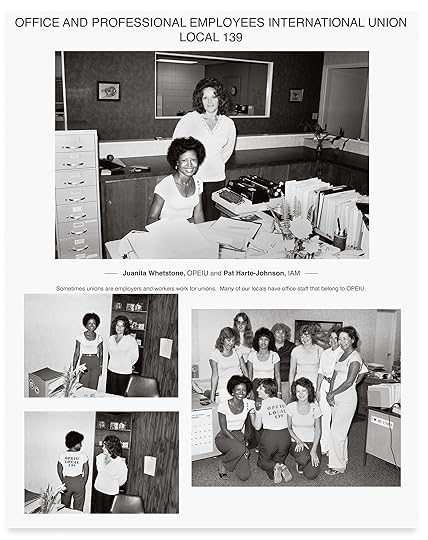 Fred Lonidier, I Like Everything Nothing But Union (details), 1983
Fred Lonidier, I Like Everything Nothing But Union (details), 1983The forum through which Lonidier engages workers is an expanded documentary practice that combines straightforward photo-text panels with direct action. In the mid-1970s, Lonidier was a key member of a tight circle of photographers and artists at the New Left hotbed of the University of California, San Diego (UCSD), which included photographers Allan Sekula, Martha Rosler, and Phel Steinmetz. As part of what was then called the New Documentary movement, these ardently Marxist photographers used theoretical texts and innovative photographic projects to mount a trenchant critical and artistic challenge to postwar humanist photography. Their coherent program of oppositional cultural practices disputed the patronizing sentimentality of much liberal documentary, with its banal construction of victims without agency, arguing that such images were merely a politically disengaged form of artistic self-expression. They challenged traditional fine-art venues, such as museums and galleries, and argued for a more militant and engaged documentary photography, one that would democratize the medium by undercutting its purported objectivity, expose the systemic economic and political systems that shaped photographic “truths,” allow voiceless workers and oppressed minorities to speak for themselves, and yoke their activist cultural criticism to pragmatic political change.
 Fred Lonidier, 29 Arrests (detail), 1972
Fred Lonidier, 29 Arrests (detail), 1972Of these artists, Lonidier was in many ways the most politically engaged and most committed to broad-based critiques of American capitalism. A former Peace Corps volunteer and convicted Vietnam War resister, Lonidier initially studied photography at UCSD as a way to make a living, possibly as a commercial photographer. But his MFA thesis project, a piece titled 29 Arrests (1972), already demonstrated his sly understanding of Conceptualism and how to disrupt the conventions of photographic tradition while foregrounding political activism. The work consists of a series of near identical shots of twenty-nine student antiwar protesters, each being held by cops while a police cameraman takes the person’s portrait. Lonidier adopted a position just behind the official photographer, offering a framing perspective that the mug shots would block out: the legions of seemingly unnecessary police surrounding the nonresistant protesters. Lonidier’s point of view and deadpan style mock the protocols of professional photojournalism. His images almost comically avoid the protest’s dramatic confrontations, showing instead the bureaucratic processing of the accused and the state apparatus in which they are enmeshed.
Lonidier’s project reveals to workers the corporate logic and patterns that lie behind specific incidents and complaints, and encourages solidarity and activist responses.
Lonidier’s best-known work, The Health and Safety Game: Fictions Based on Fact (1976–78), is an extended rumination on the brutality of the workplace and the casualties that result. He examines in explicit detail the routine violence of on-the-job injuries, which he portrays as a deliberate calculation sanctioned by the economic “game” of American industry. Across twenty-six panels that look like part of a science fair, Lonidier exposes the impact of corporate decision making, which coldly weighs the negative aspects of workers’ injuries against the steep costs of preventing them. Many of the photo-text panels feature case studies of specific incidents (“Oil Worker’s Burns,” “Office Worker’s Nerves,” “Graduate Film-maker’s Nail”), offering garish photographs of the injuries, as well as step-by-step timelines of the wounds, statements from workers, responses of employers, and testaments to the drawn-out struggles for treatment and compensation. Other text panels explain the various moves available to workers and management within the game. When confronted with health and safety concerns, management can, for example, bust the union, lobby politicians, move to another state, hire undocumented workers, underreport, counter with public relations, or simply violate the standards. Against such tactics, employees have few remedies. Lonidier’s project reveals to workers the corporate logic and patterns that lie behind specific incidents and complaints, and encourages solidarity and activist responses. “I always look for the submerged, missed, or forgotten labor issue,” Lonidier once wrote. “Much of what I have to say is already known and discussed or suspected by workers themselves. It may only be a question of legitimizing or distilling and organizing certain ideas rather than teaching in the one-way sense.”
 Fred Lonidier, I Like Everything Nothing But Union (details), 1983
Fred Lonidier, I Like Everything Nothing But Union (details), 1983But if The Health and Safety Game is critical of labor relations, other works, like the fifty-six panel I Like Everything Nothing But Union (1983), constitute a wholesale glorification of union workers marching in solidarity. Commissioned by the San Diego-Imperial Counties Labor Council, AFL-CIO and permanently installed in San Diego’s Labor Council Hall, this work was designed specifically to honor the diversity of the union, a view that goes against the univocal stereotype of blue-collar labor. Lonidier’s photographs depict a range of union members at their jobs, from clerical workers to musicians; accompanying text panels quote pithy statements from the laborers that freely offer views on the role of the union, pride in their work, and the ways labor conditions affect their lives, both on and off the job. The dedicated voices captured in this massive and optimistic study counter the conventional view of a silent workforce, grumbling about their lot and unable to represent their own interests. Instead, Lonidier presents a diverse, articulate, and highly opinionated community of workers with clear ideas about how best to achieve constructive political change.
 Fred Lonidier, Installation view of I Like Everything Nothing But Union, CLAP (Council of Freelance and Precarious Workers), Meeting Room, Officine Zero, Rome, Italy, 2015
Fred Lonidier, Installation view of I Like Everything Nothing But Union, CLAP (Council of Freelance and Precarious Workers), Meeting Room, Officine Zero, Rome, Italy, 2015 Fred Lonidier, N.A.F.T.A. #16 A/B: N.A.F.T.A… Returns to Tijuana / T.L.C… Regresa a Tijuana (detail), 2005
Fred Lonidier, N.A.F.T.A. #16 A/B: N.A.F.T.A… Returns to Tijuana / T.L.C… Regresa a Tijuana (detail), 2005As much as Lonidier’s work reflects a mutating transformation of documentary photographic practice, it also engages with a reawakened social art movement. His long-standing documentary project N.A.F.T.A. (Not a Fair Trade for All), begun in the mid-1990s, suddenly seems timely as it dovetails with widespread political condemnation in the United States of the North American Free Trade Agreement (NAFTA), which eliminated tariffs for trade between Mexico, Canada, and the United States. Even former president Bill Clinton, who signed the treaty in 1993, had insisted on amendments for granting worker and environmental protections and, more recently, has acknowledged some of NAFTA’s negative consequences. As Lonidier shows in the various iterations of his NAFTA documentary project, American companies have redirected production to low-cost light assembly plants, or maquiladoras, just across the Mexican border, thereby paying drastically lower wages and avoiding strict U.S. safety and environmental regulations. Lonidier uses photo-text panels to analyze in plain language and stark images the dire working conditions in the maquiladoras and the recent attempts by some Mexican workers to unionize. When one version of the project was shown at the Universidad Autónoma de Baja California in Tijuana in 1999, administrators closed the exhibition, claiming that Lonidier was an agitator who had distributed leaflets to workers at a nearby factory. Lonidier responded with N.A.F.T.A. #16 A/B: N.A.F.T.A… Returns to Tijuana / T.L.C… Regresa a Tijuana (2005), in which he mounted his photomontages on the outside and interior of a large cargo truck, the kind used to carry immigrant laborers across the border, and toured it to maquiladora zones near Tijuana and colleges in San Diego.
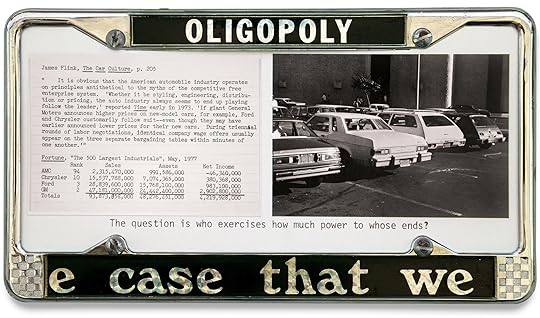 Fred Lonidier, Photo License (detail), 1978
Fred Lonidier, Photo License (detail), 1978All images courtesy the artist; Maxwell Graham, New York; Michael Benevento, Los Angeles; and Silberkuppe, Berlin
Photographs of the truck highlighted Lonidier’s contribution to the 2014 Whitney Biennial, but the culmination of his participation was undoubtedly the evening teach-in that featured Lonidier lecturing on the connections between art and the working class, and also included a rousing performance by the red-shirted, fist-clenching New York City Labor Chorus singing “Solidarity Forever.” Foregrounding the voices of workers and emphasizing the role of pedagogy, Lonidier symbolically delineated strategies for a new alignment of social-movement art, bringing resonant cultural iconography to the workplace, and inserting labor concerns into the white-cube space of the art museum. “My commitment has long been that the concerns and exhibition of social art be connected in some way to organized efforts towards the same ends,” Lonidier says. “Art that intends to challenge the social world has its best chance in tandem with social/political organizations and their allies.” This ideal remains the incomplete project of an expanded documentary photography.
Related Items

Aperture Magazine Subscription
Shop Now[image error]
Aperture 226
Shop Now[image error]This article originally appeared in Aperture, Spring 2017, “American Destiny.”
Aperture's Blog
- Aperture's profile
- 21 followers



